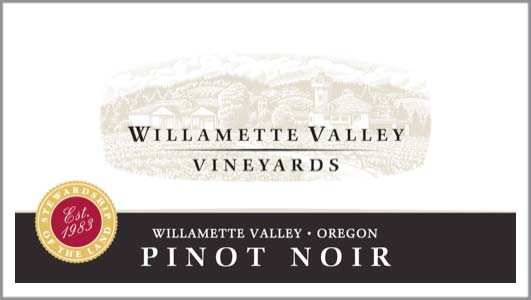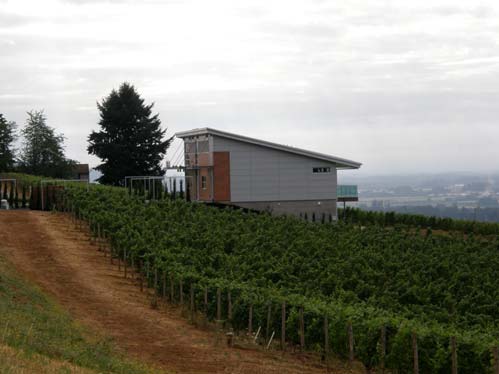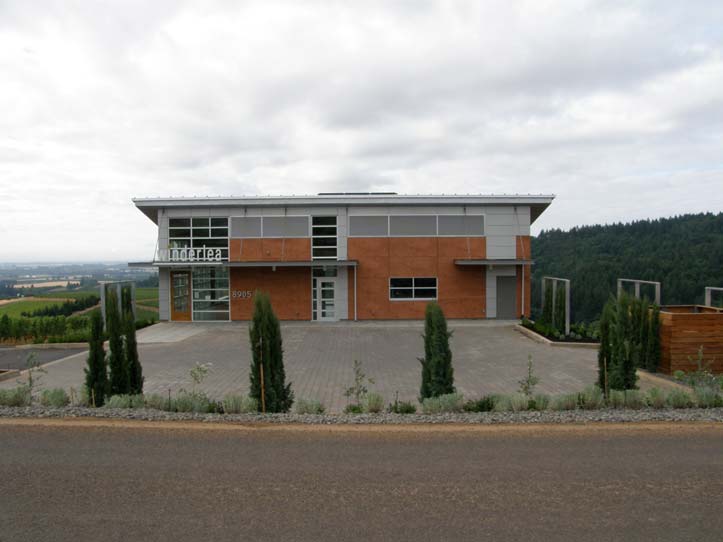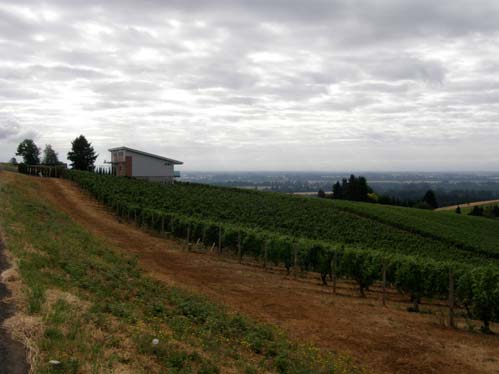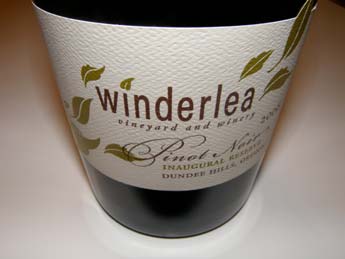PinotFile: 7.2 September 15, 2008
|
Sustaining on Pinot in NoiregonThe 22nd Annual International Pinot Noir Celebration (IPNC) was held on July 25-27, 2008 in McMinnville, Noiregon. The theme of this year’s Celebration was “Sustainability Without Sacrifice.” Oregon has led this country’s wine regions in establishing a clear and uniform description of certifiable sustainability in viticulture. Everyone wants to be “green” these days and many wineries are claiming to be green, but the trendy title is often backed up by more poof than proof. What exactly is “sustainability” and how does it relate to organic viticulture and biodynamic viticulture?
Over 700 Pinot Geeks gathered on the campus of Linfield College, located in the heart of the Willamette Valley,
eager to learn about sustainability, and dedicated to celebrating Pinot Noir in all of its diversity (translated: drink
plenty of Pinot Noir). The keynote seminar of the IPNC was “Sustainability Without Sacrifice” hosted by
distinguished wine expert and writer, Jasper Morris, MW, and noted wine writer and educator Andrea Robinson,
MS. The featured speaker was legendary and preeminent winemaker Dominque Lafon of Domaine des Comtes
Lafon. Joining Lafon on the panel were Ted Casteel, owner of Bethel Heights Vineyard in Oregon and founder
of LIVE (more about this later), Michael Dhillon, proprietor and winemaker at Bindi Wines in Australia, Ted
Lemon of Littorai Wines in California, Nigel Greening, owner of Felton Road in New Zealand, and Frédéric
Lefarge of Domaine Michel Lafarge in Burgundy. Here is the complete recording of the
“Sustainability Without Sacrifice” 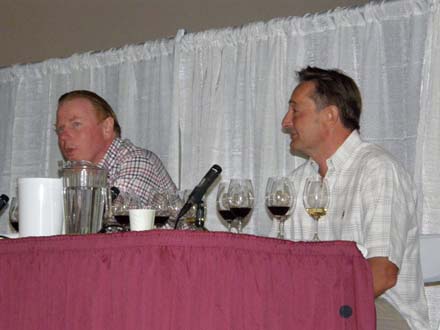 I was very impressed by Dominque Lafon who spoke with humility and clarity about his personal advocacy of organic and biodynamic farming in Burgundy. Guests were treated to a sampling of Lafon’s wines and quickly understood how sustainability and supreme quality were inseparable. Dominique Lafon (right in photo, Jasper Morris on his left) committed fully to biodynamic farming in 1995 and his estate has become one of the few in the Cote d’Or (excluding the negotiants) that produces equally good Chardonnay and Pinot Noir. This year Dominique was celebrating his 50th birthday and his 25th vintage, and frankly, he didn’t look a day over 35. He claims his favorite wine is Chambolle-Musigny Les Amoureuses, so there must be something to the relationship between love and youthfulness. The joke making the rounds at the IPNC was that the event’s “diet was not sustainable.” The copious amounts of fresh Oregon food exquisitely prepared by the top chefs in the Northwest and served at alfresco lunches and dinners daily combined with plentiful Pinot Noir from around the world made for a gastronomic bacchanal that could be only sustained for a few days. To begin a discussion of methods used to protect the health of the vineyard ecosystem, it is important to define a few terms of relevance. Consumers generally have little clue about the daunting jargon referencing “green” viticulture and winemaking and for the most part they do not need to delve into it to any serious degree. However, those looking for quality wine at the highest level may be interested in knowing about a winery’s commitment to sustainability. Many winemakers believe with good reason that sustainable practices result in brighter, purer, more flavorful wines that provide a more distinct reflection of the characteristics of the land on which they are grown. I have attempted to summarize as clearly and succinctly as possible the terms sustainability, organic and biodynamic. Sustainability: The first sustainable grape growing program to establish international guidelines originated in Switzerland in 1989. Sustainable viticulture refers to the ability of a vineyard to grow grapes while protecting the health of the environment. The basic key components of sustainable winegrowing include natural conservation, human education, water quality protection, erosion control, habitat restoration and conservation, cover crops, and safe use of soil amendments. There is no unified sustainability certification system in place in this country at present and there is no codification of sustainable farming. The United States Treasury wine label division has approved multiple “sustainable” statements but no cohesive system has been used to verify such claims. In California, the California Sustainable Winegrowing Alliance (CAWG), established in 2001, is a collaboration between The Wine Institute and the California Association of Winegrape Growers that encourages growers and vintners to adopt sustainable practices. Another organization, the Central Coast Vineyard Team (CCVT), is a nonprofit organization formed to create protocols for sustainability certification. Twelve vineyards are participating in a pilot program in 2008. Paraiso Vineyards is among the participants planning to certify all of its 250 acres and likely will be the first in Monterey County to obtain certification. By 2009, those wines made from vineyards certified sustainable by CCVT will be able to use “Certified Sustainably Grown” on labels. Oregon has led the sustainability movement in viticulture in the United States. Low Input Viticulture & Enology (LIVE) was established in 1999 to certify vineyards that follow international guidelines for strong environmental stewardship, social responsibility, and economic accountability. As Terry Casteel, longtime winegrower and proprietor of Bethel Heights Vineyards remarked during the sustainability seminar, many people came into Oregon in the early 1990s and were farming irresponsibly out of ignorance of sustainability. Casteel led the movement to establish LIVE. The LIVE grower must have a trained vineyard manager, LIVE continuing education and training, and proper record keeping on fertilization, pesticide application, pruning and soil management. Minimal and efficient pesticide application is required. Wines labeled LIVE have to be produced entirely with grapes from certified vineyards. Chaptalization and total sulfur dioxide is restricted. Reviewers visit vineyards annually unannounced to verify compliance. Currently 50% of Oregon vineyards are LIVE certified with momentum spreading to vineyards in Walla Walla, Washington, and elsewhere. The goal is to achieve complete sustainability within the Oregon wine industry. Salmon-Safe, a non-profit founded in 1995 dedicated to restoring agricultural and urban watersheds so salmon are allowed to spawn and thrive, is included in the LIVE certification. 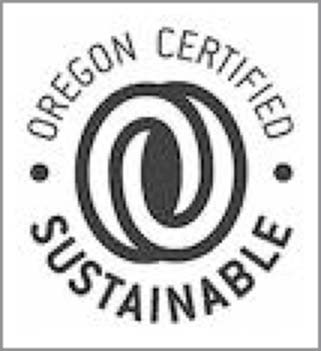 In early 2008, after the request by Governor Ted Kulongski of Oregon to reduce carbon emissions and the carbon footprint of Oregon companies, the Oregon Wine Board acted quickly to create a certification program and logo for vineyards and wineries identifying them as either sustainable, organic or biodynamic. The umbrella logo, “Oregon Certified Sustainable” (OCS) was proposed. Thirty wineries have signed on. Some resistance to OCS has been forthcoming from Oregon wineries already certified biodynamic who prefer to use that designation on their labels. Unfortunately, the maize of certifications will continue to confound the consumer for some time to come. For example, any wine certified by LIVE, Demeter, Oregon Tilth, Salmon-Safe or Food Alliance (still another certifying organization for farms, ranches and food handlers) will be able to carry the OCS label. Organic Viticulture: This method of grape growing implies farming without synthetic fertilizers, pesticides, and other chemicals. Local organizations can certify organic compliance in the United States based on Federal Organic Standards regulated by the National Organic Standards Board (NOSB). In California, certifying agencies include California Certified Organic Farmers (CCOF) and Organic Certifiers Inc.. California growers producing organic wine grapes must also register with the California Department of Food and Agriculture (CDFA). In Oregon, the organic certifying agency for organic farmers, gardeners and consumers is Oregon Tilth, established in 1974. ECOCERT, founded in France in 1991, is a European organic certification organization that conducts inspections in over 80 countries. BioGro is New Zealand’s leading organic certification agency, active since 1983. According to Lisa Shara Hall writing in Wine Business Monthly (August, 2008), California has about 9,000 acres certified (80 producers) as organically farmed while in Oregon 50% to 60% of vineyards are farmed organically even if not certified. There are three types of organic wine. For wine to be labeled “USDA certified organic,” 95% of the contents of the wine must be organic and must contain no additives such as sulfites. To be labeled “100% certified organic,” all contents must be organic and the wine must be completely free of sulfites. Since sulfites are necessary to prevent oxidation and bacterial spoilage of a wine, certified organic wines are perishable. The third type of organic wine is “wine made from organically grown grapes,” referring to wines made with at least 70% organic ingredients, restricted additives, but added sulfites. Biodynamic Viticulture: Termed biodynamie in France, this is a form of naturopathy that refers to managing the entire farm or vineyard as a self-contained holistic system and a living organism. Emphasis is given to soil fertility. Grapes must be grown and wines made without the use of synthetics and pesticides, with consideration given to the position of the planets and phases of the moon on the timing of planting, spraying and harvesting of the vines. Teas, composts and traditional recipes are used instead of synthetics. The biodynamic agricultural system was created by the Austrian philosopher, Dr. Rudoph Steiner, first detailed by him in a series of lectures in 1924. His publication was titled Agriculture (subtitled Spiritual Foundations for the Renewal of Agriculture). It is of interest that, according to Tim Patterson, writing in Wines & Vines (May, 2008), Steiner’s publication “has little to say about vines and vineyards, and there are indications he wasn’t all that fond of wine, since he wasn’t all that fond of alcohol." Steiner is also known for
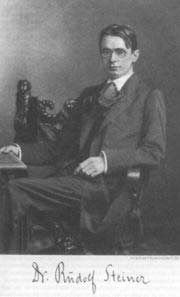 inventing the Waldorf educational system and the philosophy of anthroposophy. Biodynamics represents a belief system and a commitment beyond sustainability and organic farming. The USA Demeter Association, located in Philomath, Oregon, is the only agency for Biodynamic® certification in the United States. It is an offshoot of the original Demeter Association founded in Europe in 1928 and now has 20 country-based organizations. Nationally, California has the most biodynamic vineyards including Bonny Doon Vineyard, Bonaterra Vineyards, Frey Vineyards, Benziger Family Winery and Quivera. Oregon has at least nine producers and/or vineyards certified by Demeter including Brick House Vineyard, Cooper Mountain Vineyards (one of the first wineries in Oregon to embrace organic farming and later biodynamic viticulture), Beaux Freres Vineyards & Winery, Resonance Vineyard, Francis Tannahill Winery, Bergström Wines, and Maysara Winery. Washington has one Demeter certified producer, Cayuse, in Walla Walla. Two classes of Demeter certified wines are recognized. “Wine made from biodynamic grapes” cannot have specific additives, must be sourced from a single vineyard, and must be made with 100% biodynamic grapes. “Certified biodynamic wine” has even more restrictions, disallowing acidification and chaptalization and the addition commercial yeast, enzymes, and tannin. Sulfur dioxide can be used within specified limitations. Demeter winemaking standards are posted on the website at www.demeter-usa.org.
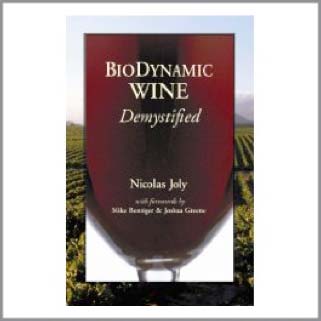 For more reading on the subject, consult Nicolas Joly’s new book, Biodynamic Wine, Demystified. Joly, proprietor of Coulée de Serrant Vineyard in France, is the world’s most influential educator on biodynamic winegrowing. His first book on biodynamics, Wine from Sky to Earth, was published in 1999. Also, there is a new book published on “green” winemaking in Oregon titled Oregon “Eco-Friendly” Wine: Leading the World in “Green” Wine, written by Clive S. Michelsen (see page 45). The book also includes a complete Oregon winery directory. Both Jory’s and Michelsen’s books are available from www.WineAppreciation.com. From personal experience, I have found that there are many Pinot Noir vineyards in Oregon and California that are farmed consistent with sustainable and organic methods, but have not sought certification because of the process involved and/or the need to leave the door open if certain pesticides are chemicals are necessary to farm the vineyard successfully. Many winegrowers practice many of the basic tenants of biodynamics as well, stopping short of some of the more obtuse recommended practices that some refer to as “vineyard voodoo.” If you want to start a controversial conversation among wine enthusiasts and wine cognoscenti, bring up the word biodynamics. Taking all the above information under consideration, what exactly is a “green” wine? At present there is no clear definition. The Green Wine Seminar will be held December 1-2, 2008 in Santa Rosa, California (www.winesymposium.com) to discuss this very subject. I tend to side with Cliff Ohmart, research/IPM director at the Lodi-Woodbridge Winegrape commission, who defines a “green” wine as one made from grapes that have been grown using either sustainable, organic or biodynamic farming methods. As he notes in Wines & Vines (September, 2008), “They are all environmentally sound ways to farm. The choice of which to practice will depend on what your goals are.”
At the Sustainability Without Sacrifice seminar, we sampled an impressive lineup of wines from the guest panelists, all of whom are firmly committed to sustainable winegrowing. Dominque Lafon’s legendary estate in Meursault is Domaine des Comtes Lafon. Lafon is one of Burgundy’s most progressive and forward-thinking personalities. As noted earlier in this article, he has been instrumental in implementing major viticultural changes in Burgundy, favoring organic and biodynamic farming.
The Desirée portion of the Volnay Santenots Vineyard was heavily virused and pulled out in 2005. Biodynamic farming was begun in 2006. This portion of the Volnay Santenots Vineyard is not 1er Cru. 2000 was a great Chardonnay vintage and this wine shows it. · Plenty of acidity and still quite fresh and young. Great purity and minerality with a crisp finish.
Lafon shares the 50 acres of Volnay Santenots with several other growers. The 10-acre du Mileu is the best part of the vineyard. A special parcel of vines more than 45 years old, Lafon consistently harvests them at some of the lowest yields in Burgundy. The vineyard typically gives intense color. All the Santenots wines are 100% de-stemmed, fermented in large tanks over a three week period and aged in one-third new French oak. Final alcohols are in the 12.6% to 13.5% range. Production is small, and much of the wine is pre-committed to top restaurants in France.
2004 Lafon Volnay Santenots-du-Mileu 2004 featured an extended growing season and was cool and rainy · A beautiful wine displaying copious black cherry fruit livened by brisk acidity and an extended and dry finish. A little grassiness peaks out on the nose, a green note that has been typical for the 2004 vintage in many parts of Burgundy.
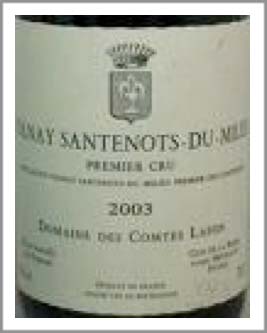 2003 Lafon Volnay Santenots-du-Mileu Grapes were sunburned in this very hot vintage. Acidification was necessary but the wine still displays a high tannin/low acid imbalance. · A noticeably riper fruit profile with a generous tannic and acid backbone.
2000 Lafon Volnay Santenots-du-Mileu A vintage complicated by rain and hail making necessary a rush to pick to avoid botrytis. · Lightest in color of the four wines tasted. Marked by elegance and extremely drinkable now with gossamer tannins and lively acidity. Very fresh tasting and still will offer good drinking for several years. (Note: the 2000 vintage in Burgundy is often overlooked, but the wines are drinking beautifully now and still can be bought on the secondary market at relatively inexpensive prices relative to more touted vintages.)
1997 Lafon Volnay Santenots-du-Mileu When asked what allows many Burgundy wines to age so well, Lafon commented that it was the balance. · Surprisingly young with plenty of tannin still to shed. Full-bodied Pinot fruit beautifully composed that lingers on the finish for an extended time.
Ted Lemon studied enology at the Université de Bourgogne and apprenticed at several famous estates in Burgundy including Domaine Dujac, De Villaine, Roumier, Parent, and Bruno Clair. He was the first American ever hired as a winemaker and vineyard manager of a Burgundian estate, Domaine Guy Roulot in Meursault. Ted ‘s years in France left him a firm advocate of terroir. He has been a leader in the implementation of sustainable farming practices in his own vineyards and region and many winegrowers seek out his guidance. All of his owned or managed vineyards have been farmed either organically or biodynamically since 1998, although Ted has not sought certification. He is now consulting on a project with Burn Cottage Vineyard in Central Otago, a neighbor of Felton Road.
2006 Littorai The Haven Vineyard Sonoma Coast Pinot Noir The Haven Vineyard is three miles from the Pacific Ocean just south of Jenner. Aged in 50% new French oak. · The aromatics feature some reduction with dark fruits enhanced by exotic woods and a touch of char. A healthy core of black raspberry and blackberry fruit with charming highlights of anise and chocolate. Young, rich and still quite tannic, the memorable finish goes on and on. I would sit on this one for a few years.
Nigel Greening bought Felton Road in 2000, and initiated organic and biodynamic farming in 2002. Felton Road’s grapes are entirely grown in their own Elms Bannockburn vineyard. Nigel is quite a character and reports that among his main ambitions in life are to break the world record for number of Rotary Clubs addressed in a single week and to beat his son Hamish (age 6) at chess,
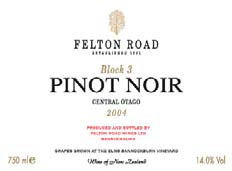 2006 Felton Road Block 3 Central Otago Pinot Noir The vineyard at Felton Road is certified organic and biodynamic. Owner Nigel Greening, an excellent speaker, noted that biodynamics “is not as wacky as it sounds.” At Felton Road, there are 75 acres planted with 250 acres unplanted. Block 3 is a subsection of the vineyard - the so-called “sweet-spot” of the vineyard. 30% whole cluster. · This is a a great wine that makes you sit up and take notice. Copious, but well framed, dark red fruit nicely complimented by savory Asian spices with an aromatic and tangy finish leaving a refreshing impression. Very classy juice.
Ted Casteel is the co-founder, co-owner, and vineyard manager of Bethel Heights Vineyard and has been growing grapes in Oregon now for 30 years. He developed the original 50-acre Bethel Heights estate vineyard in the late 1970s and the original own-rooted vines still provide most of the fruit for Bethel Heights wines. Ted has championed biological diversity and ecological balance on the whole farm, minimizing the use of “off-farm” in puts such as fungicides, synthetic fertilizers, herbicides, and diesel. His impetus led to the founding of LIVE sustainable certification in Oregon in 1997.
2006 Bethel Heights Flat Block Reserve Willamette Valley Pinot Noir Flat Block is a 30-year-old part of the estate vineyard, own-rooted, and planted to the Pommard clone. It shows the feminine side of Pinot Noir. 50% new, medium toast French oak. · Confected cherry aromas lead to nicely spiced red fruits, particularly strawberry, ending with generous acidity. Deliciously fruity and easy to drink.
The Lafarge’s have been vignerons in Volnay since the 18th century and started bottling in the early 1900s, a rarity for a small estate in Burgundy. They have had loyal customers for generations, selling their own wine in barrels to Parisian restaurants as far back as the 1850s. Michel Lafarge, now in his seventies, and his son Frédéric are probably the most famous father-and-son team working in Burgundy today. They have about 25 acres of mature vines in the village of Volnay. The domaine is committed to biodynamics.
2005 Domaine Michel Lafarge Volnay 1er Cru Les Mitans Quite young and sporting moderate tannins. Impressive structure with plenty of concentrated spiced and earth-toned fruit with a silky texture. This one will easily last twenty years.
 Michael Dhillon developed his winemaking skills on the job so to speak, becoming a traveling cellar rat at a young age. Dhillon helped his father Bill plant the original family vineyard in 1988. The Bindi vineyards are located minutes from Melbourne at an elevation of 1,600 feet. A total of 16 acres are under vine with 100 acres of associated grasslands. The focus is on farming methods that promote diversity and balance, including the increased use of biodynamic practices.
2006 Bindi Wines Original Vineyard Macedon Ranges Australia Pinot Noir A light and elegant wine that is highly perfumed with red fruits and herbs, particularly sage. Plenty of likable cherry and raspberry flavors with a healthy acid spine.
Shea Vineyard & Sine Qua Non: A Memorable RelationshipOn the Thursday evening before the start of the IPNC, I hosted a vertical tasting of Sine Qua Non Pinot Noir. Held at a house our group had rented on the Maresh estate in the Dundee Hills, we were joined by Dick and Diedre Shea of Vineyard, their winemaker Drew Voit, and winemaker Jim Arterberry of Arterberry Winery.
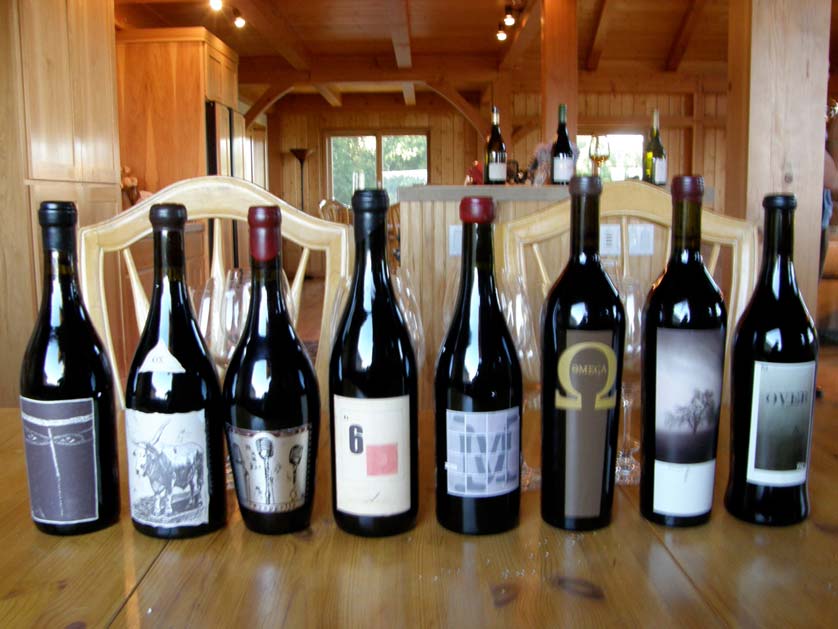 Austrian-born Manfred Krankl was well acquainted with cult wines as a managing partner of Campanile Restaurant and La Brea Bakery in Los Angeles. He had arrived in the United States at age 23 after hospitality school in Austria and began working at a hotel in 1980. Shortly thereafter he struck up a friendship with noted chef Nancy Silverton while both were staying at a resort in Greece. Together with Mark Peel, the three partners founded Campanile Restaurant and the adjacent La Brea Bakery. At Campanile he was in charge of the wine program and developed an eclectic and highly lauded wine list.
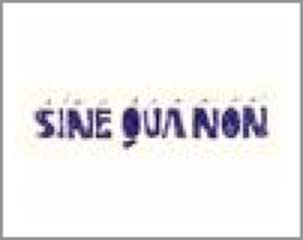 Winemaking first piqued his interest when he engaged Babcock Winery in the Santa Rita Hills to make a small amount of “house” Chardonnay for Campanile restaurant. By 1992, he had embarked on his own winemaking venture, producing a small amount of Sine Qua Non “Queen of Spades” Syrah (priced at $31) with Michael Havens of Havens Wine Cellars in Napa Valley. The name he chose for his label, Sine Qua Non, is Latin for “something indispensable.” Along with his wife and business partner, Elaine, he later made wine for several years at Alban Vineyards in Edna Valley near Arroyo Grande. His innovative approach to labeling and packaging instantly stirred interest among wine aficionados. For Krankl, no wine is ever duplicated. Every wine from each vintage is always singular so each wine is given a different name, a unique and often humorous, even scurrilous, label, and a distinctive, even odd, bottle shape. Krankl is quite a talented artist and he designs the labels himself starting with a painting and then converting the artwork to a wood cut or linoleum cut. The wines are quite distinctive. They are bold, extracted, concentrated and flashy wines often with high alcohol, but retaining a respectful balance. When asked about the alcohol levels, Krankl responds, “I am attempting to craft well-proportioned wines that have fruit, acid and tannin in balance with the alcohol. Taken alone, the alcohol level does not signify much.” It wasn’t long before Robert Parker, Jr., and other wine critics became enamored with the wines and Sine Qua Non quickly became a cult collectable. The mailing list filled up quickly (it has been closed for many years) and a lengthy waiting list followed. Krankl has remained warm to all those showing interest in his wines and often sends a card of condolences to those on the waiting list eagerly waiting for an opening. A resident of Ojai, by the late 1990s Krankl found himself driving up to 65,000 miles a year to look after his restaurant interest in Los Angeles and his winemaking in San Luis Obispo County. He sent his wife to look for a facility closer to Ojai that could be turned into a winery. Elaine found a “funky” warehouse in Ventura next to an earth moving equipment company and a surfboard manufacturer. Not exactly a typical location for a winery, but it was close to home. The warehouse was converted into a functional winery in 1997. By 2002, Krankl had become a full-time winemaker, relinquishing his interest in Campanile Restaurant and retaining a small share of La Brea Bakery after its sale.
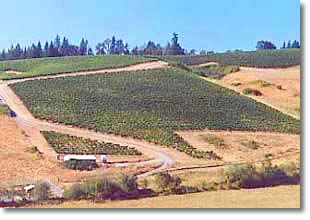 The first vintage of Sine Qua Non Shea Vineyard Pinot Noir was 1996 and the wine was labeled “Left Field.” For many years, Krankl was the only California winemaker sourcing Shea fruit. Krankl’s Pinot Noir came from a 4 acre section of the Shea Vineyard (photo right) planted to Wädenswil clone. The grapes were trucked in a refrigerated trailer to Ventura from the Willamette Valley after harvest. Dick Shea likes to tell a story that contributed to Krankl abandoning the yearly procurement of Shea fruit. One year the grapes had been picked and a large refrigerated semi showed up at Shea Vineyard. The doors were opened and out came the wretched odor of fish! It seems the truck had just completed a long haul of fish and the smell had lingered. Another truck had to be summoned while the grapes sat in bins for a lengthy period. The grapes eventually reached Krankl and the wine turned out fine. The last vintage of Sine Qua Non Shea Vineyard Pinot Noir was 2003 (“Omega”). Krankl’s block now goes to Pali Wine Co. and Loring Wine Co. in the Santa Rita Hills, and other blocks are sourced by Auteur and Roessler Cellars, both located in Northern California. Krankl made two additional vintages of Pinot Noir (2004 and 2005) from Sta. Rita Hills fruit. He decided to end his Pinot Noir program to concentrate on Rhone varietals with the eventual goal of acquiring most or all of his fruit from his own vineyards. The last vintage, in 2005, was appropriately called “Over and Out.” I have never sampled the 1996 Sine Qua Non Left Field Shea Vineyard Pinot Noir (96 cases produced, release price $36) or the 1997 Sine Qua Non Complicator Pinot Noir (87 cases produced, release price $47). A number of the other vintages have been reviewed in past issues of the PinotFile. My notes on the vertical tasting (1998-2005) held in Oregon follow. Prices listed are the lowest currently being offered on the secondary market. If you plan to pursue any of these wines, check provenance very carefully as bottles may have been shipped repeatedly among sellers and buyers through the years. Look for a seller on the mailing list who has cellared the wine since release.
2005 Sine Qua Non Over & Out Sta. Rita Hills Pinot Noir 15.2% alc., $230. · Nothing shy about this wine. The prodigious fruit is veering on the edge of super ripeness with a touch of prune peeking out. Despite the high alcohol, everything is well-proportioned. The most striking feature of this wine is the finish offering a spectacular peacock tail of raspberry and cherry fruit.
2004 Sine Qua Non Covert Fingers Sta. Rita Hills Pinot Noir 14.9% alc., $275. Also reviewed in Volume 7, Issue 1. The two Sine Qua Non Pinot Noirs from the Sta. Rita Hills show riper flavors and lower acidity. · A powerful melange of ripe black fruits attacks the mouth upon entry. Very dense and showy with an appealing softness. Nicely balanced. Not for the faint of heart.
2003 Sine Qua Non Omega Shea Vineyard Pinot Noir 15.5% alc., $230. Corked - Boo-Hoo. · The fruit is noticeably reduced but there are still tasty black cherry and plum flavors. We tried the Saran Wrap trick attempting to recover the wine but were unsuccessful.
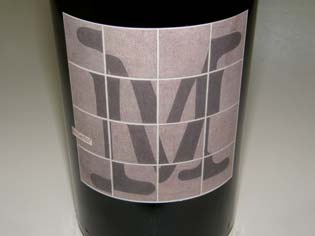 2002 Sine Qua Non Hollerin M Shea Vineyard Pinot Noir 15.4% alc., $350. Also reviewed in Volume 7, Issue 1. This is one of the greatest Sine Qua Non Pinot Noirs and the highest rated Oregon Pinot Noir ever. · The nose speaks of the soil and wild dark berries with a touch of alcohol. In the mouth there is sumptuous dark fruit highlighted by earth, tobacco and mocha that fills the mouth. A velvety texture and a long, scented aftertaste will satisfy any hedonist.
2001 Sine Qua Non No. 6 Shea Vineyard Pinot Noir 14.2% alc., $220. The grapes in this vintage were large and flavors were not particularly concentrated. The wine was not highly rated upon release. · A very fruity and fresh Pinot that draws you in with showy dark stone fruits and underlying earthiness. The tannins are silky and the overall impression is that of a very decent, but not extraordinary wine.
2000 Sine Qua Non a’Capella Shea Vineyard Pinot Noir 14.3% alc., $200. Consistently good weather during this vintage. · I have tasted this wine on several occasions and it has always charmed me. Complex aromas of dark red fruits, mushrooms, coffee, minerals and hi-tone spice. A seamless wine that is just starting on the downhill slope. Drink up.
1999 Sine Qua Non Ox Shea Vineyard Pinot Noir 14.0% alc., $190. A prolonged vintage with harvest extending into November. There was very little maturity and color change in early September and the vintage was saved by heat in October. · A substantial and fruity wine with great intensity. Still young and sporting noticeable tannins. Plush earth-dusted black cherry flavors with a woodsy and forest floor finish.
1998 Sine Qua Non Veiled Shea Vineyard Pinot Noir 14.0% alc., $220. A warm vintage, just short of 2003 in seasonal heat. · Very fresh and aromatic sporting darker fruits and complimentary spice. Thoroughly enjoyable to all who tasted it. Impressive for its longevity.
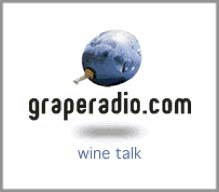 Sine Qua Non has both a spring and fall release. To inquire about the waiting list, fax your request to 805-649-8902. The Sine Qua Non winery is not licensed for tastings. A personal interview with Manfred Krankl was recorded by the Grape Radio crew in 2006: Part 1 and Part 2, December 4th, 2006 and posted as part of the past programming at www.graperadio.com. Listening to the interview, I was impressed by how much credit Manfred gave his wife Elaine. He admitted that he couldn’t do his job without her, relying on her unbiased opinion about the wines, her dedicated office work, and her ability to keep him grounded every day. This scenario is common in the wine business. Spouses of winemakers and winery owners often are in the background, but frequently success is predicated on the spouse’s unselfish and unpublicized contributions.
Twenty-Second Annual International Pinot Noir CelebrationThe granddaddy of Pinot Noir Festivals continues to annually attract pinotphiles from around the world to the tiny campus of Linfield College in McMinnville, Oregon. This year, Pinot Noir producers hailed from Oregon, California, Canada, France, New Zealand, Australia (including Tasmania), and Austria. Since 1987, the IPNC has hosted a total of 252 foreign wineries. Chefs travel from all parts of the United States, France, Canada, Japan and New Zealand to cook for IPNC participants. Forty-six guest chefs prepared the meals this year at the Celebration. Traditionally, the Opening Ceremonies feature an introduction of the featured winemakers. This year the Master of Ceremonies, Andrea Robinson, welcomed 63 Pinot Noir producers. Pictured clockwise are David Millman, Managing Director of Domaine Drouhin Oregon,
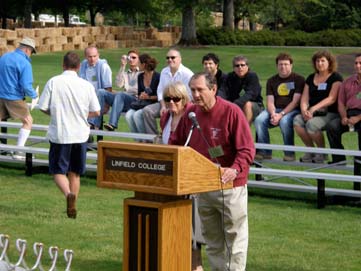 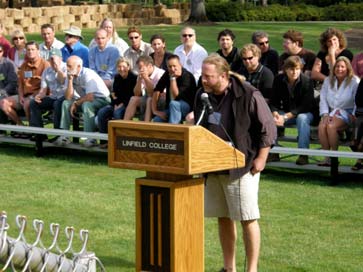  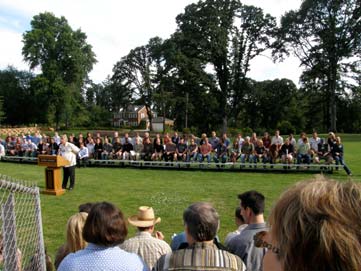 Dan and Nancy Chapel of Cardwell Hill Cellars in Philomath, Oregon, Adam Campbell, winemaker at Elk Cove Vineyards, and the entire group being addressed by Laurent Montalieu of Solena Cellars. Usually the Opening Ceremonies are held in front a a 250-year-old oak tree (below in 2007) which was an enduring symbol of Linfield College and a frequent image on college stationary and calendars. The oak had predated the founding of Linfield College, now celebrating its Sesquicentennial (1858-2008). Named the Old Oak, the 80-foot tree came crashing down on January 8, 2008, a victim of carpenter worm infestation.
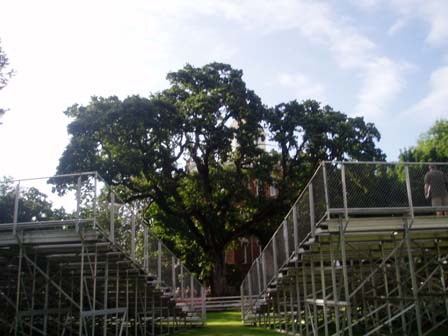 After the Opening Ceremonies, attendees scattered by bus throughout the Willamette Valley to learn about sustainable viticulture at several of Oregon’s most notable wineries and enjoy an alfresco lunch. My group took a fifteen minute ride to Amity Vineyards in the Eola-Amity Hills appellation. Established in 1976, Amity is one of Willamette Valley's first wineries. When Myron Redford founded Amity Vineyards, there were only about twelve other wineries in the state of Oregon. The 15-acre estate vineyard is perched on a hillside with panoramic views of the Willamette Valley. 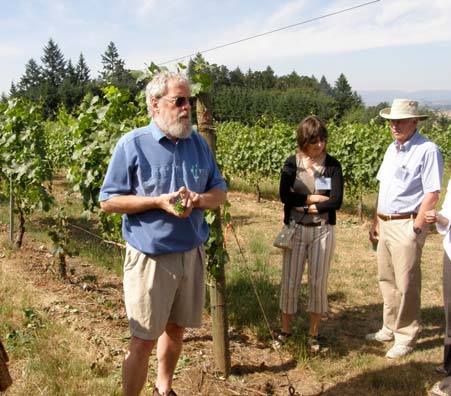 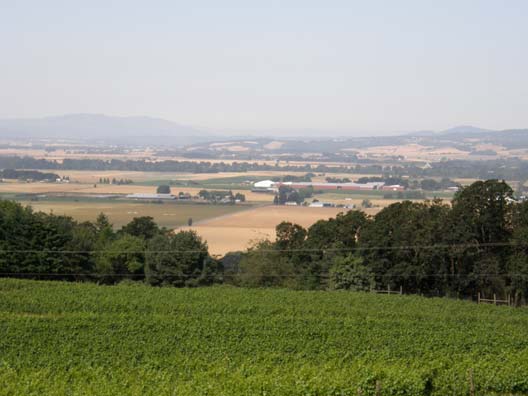 Owner and winemaker Myron Redford (pictured) is a respected veteran Oregon vintner who oversees the 8,000 case production of Pinot Noir, Pinot Blanc and Riesling at Amity Vineyards. Early in his career, Redford was an advocate of little or no new oak in vinifying Pinot Noir and his Pinot Noirs were austere with plenty of acidity. Although he strived for elegance in the mold of his idol, Roumier, and achieved that in a number of his wines, the Pinot Noirs lacked the fruitiness that consumers tody often prefer. Most recently, his Pinot Noirs are more in step with other producers in Oregon, showing more ripeness and body. Redford’s white wines have always been excellent and noted for their purity and vibrancy. Our Oregon Wine Country lunch hosted by Myron Redford and Vikkie Wetle of Amity Vineyards was prepared by two young kitchen talents, Eric Ferguson and Carmen Peirano of Nick’s Italian Cafè in McMinnville. Nick Peirano started the eponymous restaurant in 1977, and his daughter and fiancee have bred new life into this venerable wine country restaurant. Two notable Pinot Noirs were served at lunch. The 2007 vintage of Amity Vineyards Eco-Wine Pinot Noir (13.7% alc., $27) was a pleasant, light and fruity Pinot Noir. The 2006 vintage of this wine, which is organic and has no detectable sulfites, won a Gold Medal at the Oregon State Fair. I was very impressed by the Sunnyside Vineyard Pinot Noir served with the main course (grilled rack of lamb and summer vegetable ragout).
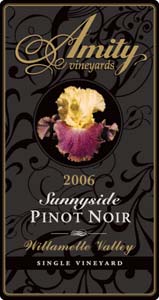 2006 Amity Vineyards Sunnyside Vineyard Willamette Valley Pinot Noir 14.5% alc., 203 cases, $40.The Sunnyside Vineyard was planted in 1970 and is LIVE certified. The owners are Tom and Lucy Wisniewski. Fruit from this vineyard been a part of the reserve Pinot Noir at Amity in the past. Aged 10 months in oak. · Beautifully weighted and composed with generous flavors of fresh berries including cranberry, and cherries. Floral and fruity in the nose and silky in the mouth. Impeccable balance, and a perfect companion to grilled lamb.
Amity Vineyards is located at 18150 Amity Vineyards Rd at the southern edge of Yamhill County. The wines are sold on the website at www.amityvineyards.com. Amity Vineyards is one of the few wineries with a tasting room open daily year round. 503-835-2362.
IPNC is a heaven for gourmands as well as pinotphiles. Noted chefs work in teams using local artisan and sustainable foods to prepare superb luncheons and dinners. The Alfresco Lunch on Saturday was quite innovative with pork being the centerpiece for all courses. The menu is duplicated below. It was fairly warm that day and if you look closely at the crowd in the photo on the next page, you will see the clever hats that were fashioned from the cloth napkins to protect a number of bald heads.
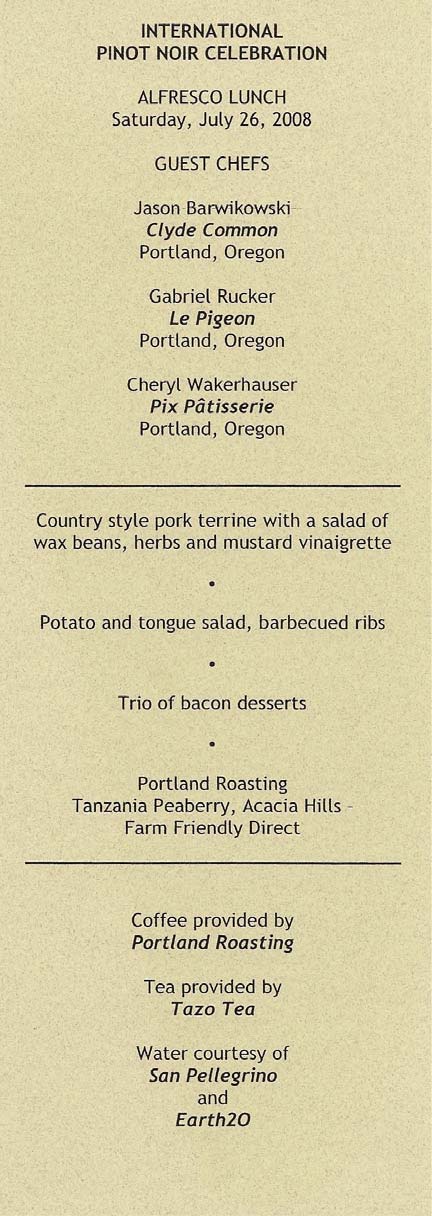
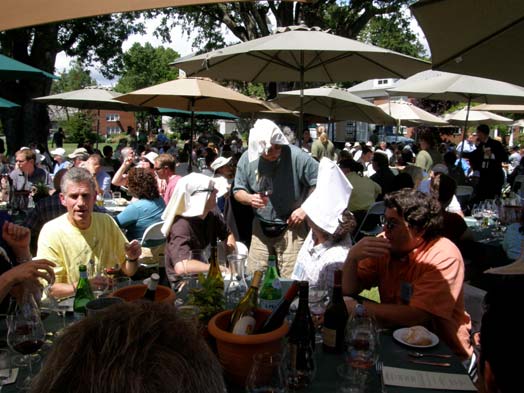 A much-loved tradition at IPNC us the Northwest Salmon Bake held in the Oak Grove at Linfield College. Wild Chinook salmon is prepared on alder stakes over a huge fire pit. For meat eaters there was a Provencal stew of Cattail Creek lamb shoulder and mesquite grilled Carlton Farms pork loin. This is an all-you-can-eat and allyou- can-drink affair in which every attendee brings one to several prized bottles of Pinot Noir to share. Once you have sampled everything at your own table, you are free to scavenge with your glass hunting for gems that often are generously offered by other tables. The pictures below capture the atmosphere of the event.
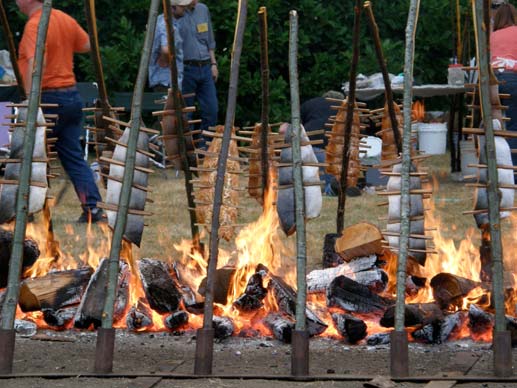 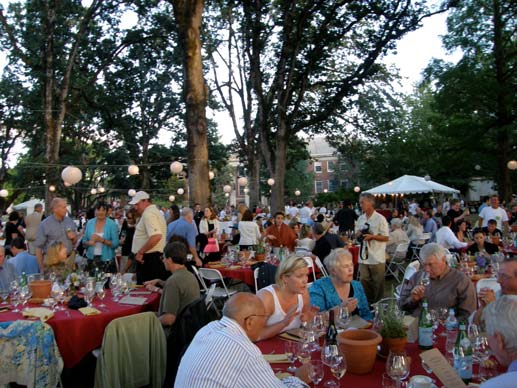 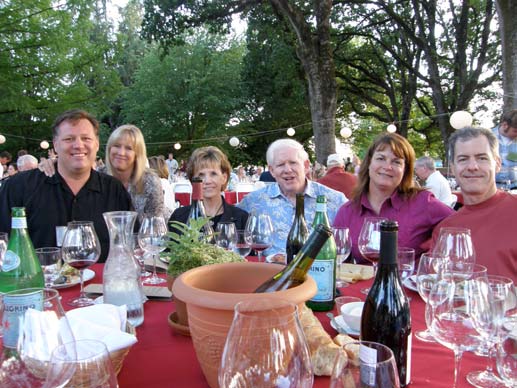
PinotFile Centerfold
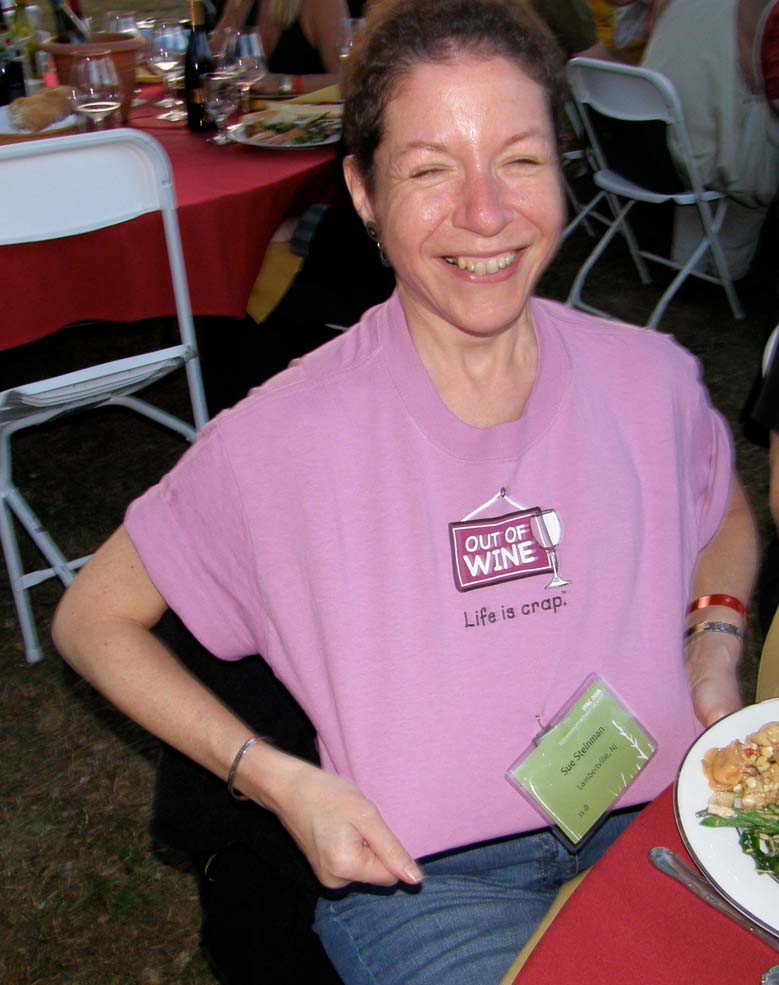 Name: Sue Steinman Profession: Attorney. Will litigate for wine Home: Recent transplant from the East Coast to Oregon’s Willamette Valley Favorite Wine: Privé Willamette Valley Pinot Noir Favorite Pastime: Smiling and laughing Ambition: Scoop the Prince on a Pinot story
Evening Land VineyardsWhen word got out that Dominque Lafon had started making Pinot Noir in Oregon, it created quite a buzz. He has signed on as the consulting winemaker for Evening Land Vineyards (ELV), a wine label started by former attorney and producer and director in Hollywood, Mark Tarlov, along with partners Danny Meyer (Union Square Hospitality Group), the Prieur family of Domaine Jacques Prieur, and Dorothy Cann Hamilton, founder of the French Culinary Institute in New York City and CEO of the James Beard Foundation. Evening Land Vineyards owns two vineyards in California, Occidental Vineyard in the Sonoma Coast (the source of Kistler’s Cuvee Elizabeth before it was acquired by ELV) and Odyssey Vineyard in the Sta. Rita Hills. Pinot Noir from these two sites is crafted by veteran winemaker Sashi Moorman (Stolpman Vineyards). Lafon declined to make Pinot Noir from California, claiming the wines were too extracted and high in alcohol. As widely reported in the wine press last year, Tarlov and his investment group signed a long term lease of Seven Springs Vineyard, a revered 65-acre Pinot Noir vineyard in the Eola-Amity Hills appellation. Tarlov had been attempting to purchase the vineyard outright since 2004 without success. Seven Springs Vineyard was split by a divorce of the original owners of Seven Springs Vineyard in 2001 into Anden Vineyard, owned by Al McDonald, and Seven Springs Vineyard, owned by his former spouse, Joni Weatherspoon. When Joni died in 2003, her children took over ownership. The vineyard has been rechristened and unified as Seven Springs Vineyard under the ELV lease. Seven Springs Vineyard has been the source for Pinot Noir from several esteemed producers including Adelsheim, Bethel Heights, Cristom, Domaine Drouhin, Evasham Wood, Penner-Ash, Rex Hill, and St. Innocent. None of these wineries will continue to receive fruit after the 2008 vintage. St. Innocent will be the most affected as they source about a third of the fruit originating from Seven Springs Vineyard. Considerable investment by ELV is being directed at enlarging and improving the vineyard which has some phylloxera-damaged vines over twenty-five years old. The full-time winemaker in Oregon for Evening Land Vineyards will be Isabelle Meunier who previously worked at Le Clos Jordanne in Niagara, Canada, with former Oregon winemaker, Thomas Bachelder. According to www.winebus.com (12/04/07), the winery plans to release 5,000 cases annually of Pinot Noir, Chardonnay and Gamay Noir. The first wine, labeled ELV Celebration, is a Gamay Noir released in 2008. Two 2007 ELV Seven Springs Vineyard Pinot Noirs (said to cost $50 and $100) will follow in 2009. I have seen conflicting reports in the wine press about the eventual winery site, some reporting that ELV will move into the expanded quarters at Carlton Winemaker’s Studio, and other sources stating that a new winery is being built in Salem, Oregon. This new venture also features a partnership between several sommeliers and restaurant groups and ELV. Some of the sommeliers will work with Dominque Lafon to produce special cuvees for their restaurants, including Daniel Bouloud’s Dinex Group and Jean-Georges Management in New York. Other sommeliers will partner with other winemakers of their choosing. To sign up for the mailing list, visit the website at www.elvwines.com. The phone is 707-320-9372. It is unclear how much of the wine will be allocated directly to consumers.
A Taste of Noiregon, Vintages 2005 & 2006The Willamette Valley of Oregon has become a treasure chest of Pinot Noir. The wines of the 2005 and 2006 vintages demonstrate commendable quality and consistency. 2005 was a warm and dry vintage. The early part of the year was the driest on record in the Willamette Valley. Rains finally came in May during bloom reducing the crops levels. Summer was warm, but not hot, allowing extended hang time and comfortable harvesting before the November rains arrived. 2006 was an ideal vintage marked by a mild spring with ideal fruit set, and a warm summer (the only warmer vintage in Oregon was 2003). Only a few hot days marked the fall and harvest continued smoothly. The resultant wines have excellent flavors and natural balance. 2006 marks the 40th anniversary of Oregon’s Pinot Noir industry. David Lett arrived in the Willamette Valley in 1965, a fresh graduate of University of California Davis and 3,000 cuttings in tow. He had chosen Oregon despite the widespread teachings of the time that vinifera would not prosper and ripen in Oregon. He groomed his cuttings in a nursery until he found a suitable site in the Dundee Hills. In 1966, Lett planted Pinot Noir, Chardonnay and Pinot Gris and Eyrie Vineyards was born. He bought a small chicken processing plant in McMinnville and began making wine. Lett is acknowledged as the first to plant Pinot Gris in America, but whether he or Charles Coury was the first to plant Pinot Noir in the Oregon is uncertain. Charles Coury began his career in the wine business in California as a sales representative for Julius Wile Importers but soon decided to attend University of California Davis to learn to make wine. His now famous Master’s Thesis of 1963 was titled, “Cold Limit Amelioration Hypothesis.” He was convinced that vinifera produced the best wine when it ripened at the upper limit of the growing season. Armed with this theory, he also set out for Oregon, convinced that the climate there most closely approximated that of Burgundy. He planted Pinot Noir in Forest Grove, just west of Portland, and made some very credible wines. Lett is the most well-known of the pair and is often referred to as “Papa Pinot.” Coury eventually left the wine business and founded the first microbrewery in Oregon. It wasn’t long before many other pioneering winegrowers arrived in Oregon, including Dick and Kina Erath, Cal Knudsen, Dick & Nancy Ponzi, Suzanne and Bill Sokol Blosser, David and Ginney Adelsheim, Jim and Loie Marsh and many others of importance but less repute. At the end of the 1980s there were 1,000 acres of Pinot Noir vines in the Willamette Valley. By the year 2000 there were 5,000 acres of Pinot Noir, a total estimated to at least double by 2010. Major vineyard investors are now prominent in the Willamette Valley including Wine Trust and Premier Pacific Vineyards who lease blocks in their managed vineyards to wineries on a long-term basis.
Angela is a single Pinot Noir produced from a single vineyard, Clawson Creek Vineyard, in the Yamhill-Carlton appellation of the Willamette Valley. The owners are two husband-and-wife teams who have taken their passion for wine to the next level buying and developing a new vineyard and proudly releasing their first wine in 2008. Antony Beck is part of the family that owns Graham Beck Wines of South Africa and he oversees the family’s thoroughbred horse breeding farm in Kentucky. His wife, Angela Beck, is an entrepreneur herself, owner of a designer table linens and accessory company called Pomegranate, Inc.. Robert Rosenstein is a wine and spirits retailer, also located in Kentucky, and his wife, Dr. Kim Clawson Rosenstein is a practitioner of integrative medicine. Beck met up with noted winemaker Ken Wright who led them to a special site for Pinot Noir located on a ridge in the Yamhill-Carlton District. One of the unique features of the site is the consistent layer of 30 to 36 inch top soil throughout the site. Under the direction of vineyard manager, Mark Gould, planting of 21 acres started in 2006, with another 13 acres following suite in 2007. The clones are Dijon 115, 777 and Wädenswil 2A. In March of 2008, the inaugural Angela Pinot Noir was released. Ken Wright crafted the wine. Although the label says Clawson Creek Vineyard, the grapes for this inaugural wine must have been sourced elsewhere as the vines were first planted in 2006.
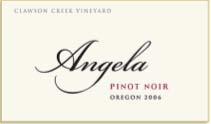 2006 Angela Clawson Creek Vineyard Yamhill-Carlton District Oregon Pinot Noir 13.5% alc., 400 cases, $50. Aged 10 months 60% new French oak. · Dark reddish-purple robe. Fragrant aromas of black cherry, plum, prune and toasted oak entice. A plush and rich palate of black cherry, cassis and blackberries with a subtle woodsy note. Smooth with soft tannins and a healthy acid spine. A compelling wine of great merit.
Angela Pinot Noir is available through limited retail distribution. Sign up for the mailing list on the website at www.angelapinotnoir.com.
Antica Terra ("old earth" in Latin) was started by a pair of New Yorkers in 1989 who made small amounts of distinguished Pinot Noir for several years. The vineyard and label was bought in June of 2005 by three friends and partners who brought in talented winemaker Maggie Harrison, a former assistant winemaker to Manfred Krankl at Sine Qua Non in Ventura, CA. The 6-acre estate vineyard is in the Eola-Amity Hills appellation. Annual case production is 850 cases. The inaugural release vinified by Maggie Harrison is the 2006 vintage. The Willamette Valley bottling is a blend of grapes from the Eola-Amity hills property (52%) as well as Amity Hills Vineyard, Shea Vineyard, and Croft Vineyard. A second, more limited, release is called Botanica ($62), made in superior vintages. The 2006 version is limited to 173 cases and is primarily Shea Vineyard fruit.
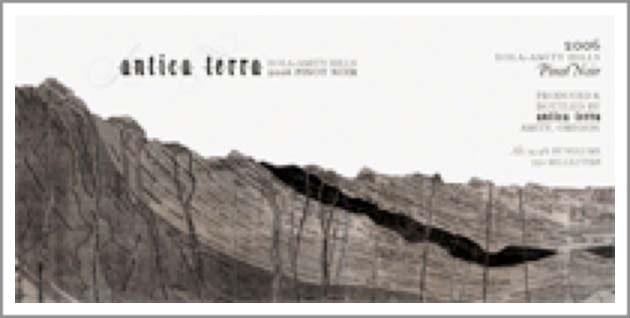 2006 Antica Terra Willamette Valley Pinot Noir 14.4% alc., $46. Bottled in a tall Riesling-type bottle. · Deep reddish-purple color. Alluring aromas of black cherry, fresh berries and toasty oak leading to a full-on delicious black cherry and ripe plum attack. A touch of earth, spice and anise adds interest. Rich, velvety and full with bracing acidity on the finish.
Antica Terra is distributed through retail channels in Oregon and sold on the website at www.anticaterra.com. 503-244-1748.
The Maresh family has had a long and memorable presence in the Dundee Hills of Oregon. I spoke with Martha Maresh and she detailed the family history. Jim and Loie Maresh were Wisconsin natives who met as students at Marquette University. The two bought a 26-acre farm in the Dundee Hills in 1959. They expanded their holdings as Jim worked for Dunn & Bradstreet and served as a reserve officer in the Navy in Portland. Originally, theirs was the only home on their hill and they enjoyed the life of farming cherries, nuts and prunes. In 1969, David Lett had the only vineyard in Yamhill County. At the time, Dick Erath suggested to the Maresh family that they had a superior site for growing grapes. In 1970, they followed his suggestion and planted three acres of vines. Jim and Loie had five children. One daughter, Martha, married Fred Arterberry who was one of the first Oregon winemakers to have a degree from University of California Davis. Arterberry was well known in wine circles in Oregon and produced many award-winning wines. Martha and Jim had a son, named Jim Arterberry Maresh. When the eldest Jim died, Martha remarried but kept the last name Maresh. The Maresh estate now consists of 124 acres of several varieties including Pinot Noir and Chardonnay. About half the grapes (600 cases) are vinified as Red Barn Pinot Noir. This wine has been made by several winemakers through the years (the Maresh’s traded grapes for wine) and sold only through the Red Barn tasting room. The remainder of the grapes Pinot Noir are sold to Daedelus Cellars, et Fille, Scott Paul, and Sineann. Rex Hill produced a Maresh Vineyard Pinot Noir for many years until the winery was sold a few years back. Martha is not only a dedicated vineyard worker, but quite a talented baker. When we stayed at the Maresh Retreat, she was kind enough to bake us a cherry pie from her 80-year-old Queen Anne cherry trees and this was the best pie I had ever eaten in my life. The large four bedroom house on the property has become a community gathering spot and is available for rent (www.vineyardretreat.com). The tasting room is a short stroll away and is pictured on the right. Two views of the Maresh Vineyard are below. Note the deep rust-red color of the Jory soil, the origin of the name, Red Hills of Dundee.
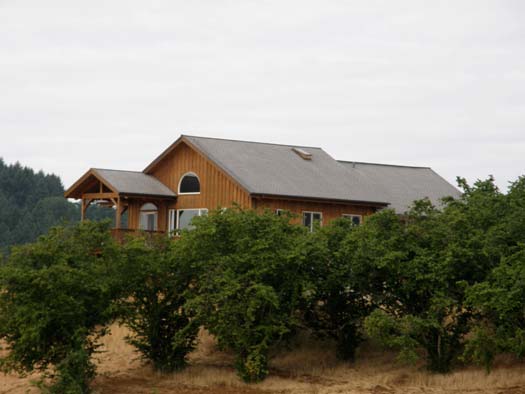 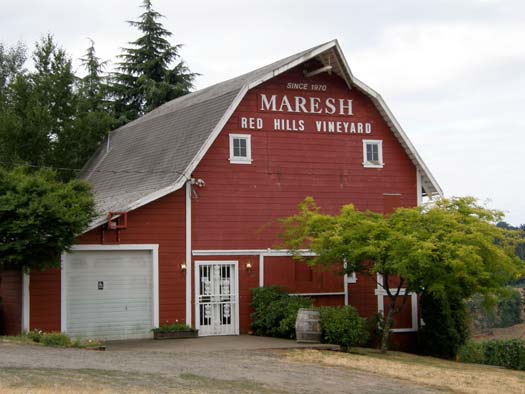 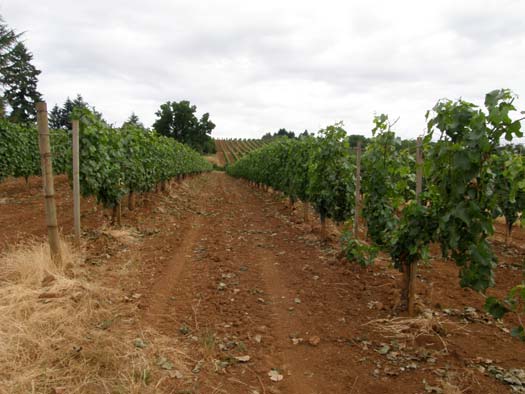 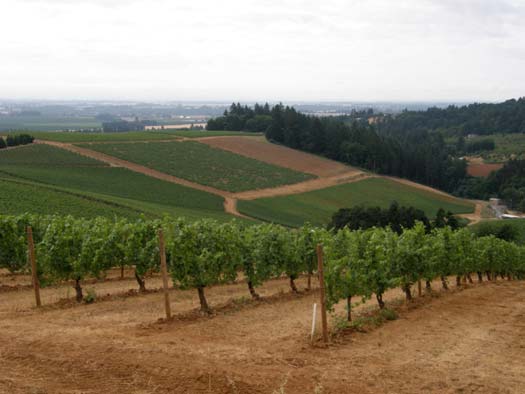 Jim Arterberry Maresh is only twenty-four years old, but is already becoming touted as the “Best Young Oregon Winemaker” (see www.avalonwine.com). His father’s label, Arterberry Cellars, disappeared when Fred died. Jim began “messing around” making wine in 2001, and in 2007 he revived the label as Arterberry Maresh, releasing his inaugural wines from the 2005 vintage. His 2006 Pinot Noirs are quite impressive and three of them are reviewed below. The aromatics and elegant style are especially notable. All wines are hand-crafted and spend 18 months in barrel.
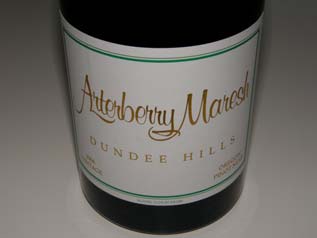 2006 Arterberry Maresh Dundee Hills Oregon Pinot Noir 13.5% alc., 125 cases, $35. This wine is made from declassified old vine fruit from non irrigated vines in the Maresh Vineyard. · Displaying a lighter crimson color than the other two Arterberry wines, the nose is classic Chambolle with hitoned red cherry, baking spice and oak. Redder fruits including strawberry are nicely weighted and balanced with bright acidity and subtle oak tannins. The flavors and aromas dissipate with time and air. A comforting Pinot that the Pinot Geek likes to drink now.
2006 Arterberry Maresh White Rose Vineyard Dundee Hills Oregon Pinot Noir 13.9% alc., 50 cases, $75. · Aged in neutral oak but still showing some aromas of new sawn oak along with bright cherries and berries. Discreetly concentrated black cherry and blackberry flavors envelope the tongue with a silky creaminess. Commendable balance of perfectly ripe fruit, lively acidity and fine-grained tannins. I was wanting for a little more lingering finish.
2006 Arterberry Maresh Maresh Vineyard Dundee Hills Oregon Pinot Noir 13.5% alc., 75 cases, $75. From non irrigated old vines. · Intense deep, dark reddish-purple color. Alluring and complex aromatics brimming with ripe grapes, plums, fresh bread and herbs. Darker Pinot fruits carry the theme on the palate with overtones of savory herbs, forest floor and oak. A commendable effort that has a subtle richness and refined mouthfeel. This wine has impressive breeding and it shows it.
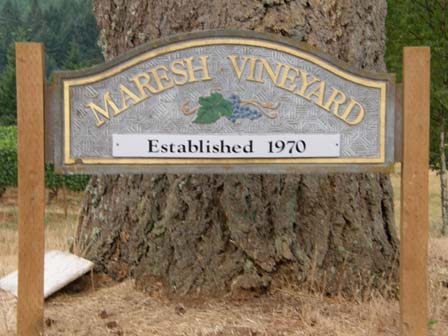 Arterberry Maresh wines are sold through limited retail distribution within Oregon. Avalon Wine Co. is source (http://avalonwine.com/Arterberry-Maresh-Cellars-2006-Wines.html). 503-434-7689. You can reach Jim Maresh through the website at www.arterberrymaresh.com.
This is one of my favorite Oregon wineries and I stock my cellar with Cristom Pinot Noirs on a regular basis. The wines are consistently excellent, age very well, and show a Burgundian sensitivity. In addition, Cristom Pinot Noirs are available in half-bottle sizes for earlier consumption. Cristom's founder and owner, Paul Gerrie, used his skills as an engineer and avid researcher to pursue his passion for wine. On his travels to France, he was introduced to the traditional growing practices of the Burgundy region. He learned that soil (terroir) and site were key in developing the complexity of the fruit. After a 1991 visit to the International Pinot Celebration in Oregon, Paul decided the time was right to leave the East Coast and bring his family and his passion for great Pinot Noir to Oregon's burgeoning wine country. Their dream wasn't complete without a winemaker who shared Paul's vision of "letting the land make the wines." Enter Steve Doerner who, after a quarter century of experience, still believes the winemaker's job is to "optimize what nature and the vineyard provides." Besides his reputation as a master winemaker with "keen intuition" (possibly from his French heritage), Steve graduated from University of California Davis with a degree in biochemistry and never intended to make wine originally. He eventually found his way to Calera Vineyards with owner Josh Jensen and stayed fourteen years. He also studied under Jacques Seysses of Domaine Dujac. The engineer and the biochemist set out to cultivate their vision in 1992, which today, can be seen in the seven distinct vineyards on Cristom's 65 acres in the Eola-Amity Hills appellation. The vineyards are dry-farmed, planted to high density and yields are strictly reduced. The Pinot Noir vineyards (named after family members) include Marjorie, Louise, Jessie, Eileen and Emilia, and vineyard-designates are produced from each. There is also a Sommers Reserve and a Mt Jefferson blend of the appellation. An equally fine Chardonnay and Pinot Gris are also produced. Experimentation with Viognier and Syrah has begun, both varietals that are rarely found in the Willamette Valley. Production is about 10,000 cases annually. The Pinot Noirs are vinified using native yeasts and with minimal handling. Gravity is used at every step and the wines are unfiltered. All the wines display stunning aromatics which pick up intensity in the glass and soft, caressing textures. There is plenty of beauty in the wines below and like a Miss Oregon pageant, hard to pick a winner. If I could have only one, it would be the 2006 Cristom Eileen Vineyard.
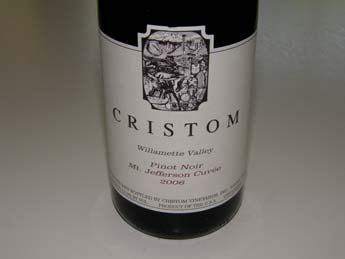 2006 Cristom Mt. Jefferson Cuvee Willamette Valley Pinot Noir 13.5% alc., $24. Composed of fruit from the five estate vineyards and purchased grapes. · Demure scent of Bing cherry and oak spice. Delicious bright red fruits, especially red raspberry with a respectful hint of oak and stylish baking spices. Velvety in the mouth, clean, harmonious and perfectly balanced. Immensely satisfying and ready to drink now. You won’t find a better Oregon (or California, for that matter) Pinot Noir for $24.
2006 Cristom Eileen Vineyard Eola-Amity Hills Willamette Valley Pinot Noir 14.5% alc., $42. · Stunning scents of red Pinot fruits, particularly strawberry with a sidecar of oak. Beautifully composed demure cherry core which has unbelievable persistence. A creamy and seamless wine that is about as perfect as it gets.
2006 Cristom Sommers Reserve Willamette Valley Pinot Noir 14.5% alc., $38. · Shy and simple cherry aromas with a hint of newly mown grass. Sturdy cherry and strawberry fruit with sinew, nicely weighted and elegant, showing some dry but refined tannins and a touch of heat on the finish. Immature and a bit disjointed, give this wine a few years to fully integrate.
2005 Cristom Jessie Vineyard Eola-Amity Hills Willamette Valley Pinot Noir 13.5% alc., $24 (375 ml). · Wonderfully scented with spiced cherries. Black cherries and black raspberries offer great purity of flavor. Graceful and supple, with a velvety texture and a pleasing and long dry finish. An impressive effort.
2005 Cristom Marjorie Vineyard Eola-Amity Hills Willamette Valley Pinot Noir 13.5% alc., $24 (375 ml). · The nose starts off with cherries and a hint of sage, cardamon, and char. With air, the aromas pick up intensity and fruitiness showing an intense cherry scent. A subtle and discreet wine strutting tasty black cherries, savory herbs, some earth and a hint of chocolate. A sensual creamy texture urges you to take another sip.
Cristom wines are distributed through fine wine stores and are sold on the website at www.cristomwines.com. A seasonal tasting room is open at the winery located at 6905 Spring Valley Road NW in Salem. The phone is 503-375-3068.
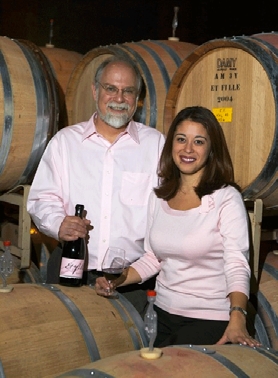 Howard Mozeico started making wine in his garage in 1984. He became quite accomplished, garnering seven Gold Medals for his Pinot Noir in seven state home winemaking competitions. He was encouraged by friends and relatives to become a full-time winemaker and when his daughter, Jessica, agreed to assist him with the 2000 vintage, he began his commercial winemaking career. The name Et Fille (“a few”) was chosen, which in French means “and daughter.” Howard jokes, “Mozeico Et Fille” just wouldn’t work. His wines have been well reviewed and soon he plans to leave the software company he co-founded to devote himself entirely to Et Fille. Howard’s goal is to craft small lots of distinctive single vineyard Pinot Noirs that reflect the unique character of each individual vineyard. No two of his wines are vinified exactly in the same fashion, making each wine a distinctive expression of a specific Oregon terroir. He sources grapes from several prime vineyards including the well-known Maresh Vineyard. The wines are vinified at August Cellars, a modern gravity flow winery just off Highway 99W in Newberg. August Cellars was founded by Tom Schaad and is fashioned after the Carlton Winemaker’s Studio, which hosts ten wineries under one roof. At August Cellars, eight separately bonded wineries share space and equipment. Each winery has its own dedicated space for storing barrels during the blending and aging process. The facility opened in 2004. Production at Et Fille is small, about 1,500 cases. The wines are all aged for 10 months in 44%-50% new French oak. The 2006 vintage lineup of Et Fille Pinot Noirs is impressive. All the wines are marked by balance with nothing sticking out. The winemaking shows a light hand with the wines elegantly weighted and presented. Tres Pinot.
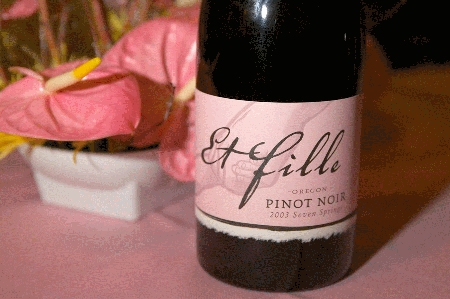 2006 Et Fille Willamette Valley Pinot Noir 14.2% alc., 83 cases, $28. All Pommard clone. · Some barnyard blows off quickly to reveal lovely scents of black cherry. There is an appealing and glass-filling presence of sweet strawberry, raspberry and cherry fruit with some underpinnings of earth and spice. The finish is pleasant but short. A great everyday Pinot and quite good for an appellation blend. Jessica Mozeico says, “Like Cameron Diaz - fun, spirited and more attractive than the girl next door.”
2006 Et Fille Palmer Creek Vineyard Eola-Amity Hills Willamette Valley Pinot Noir 14.1$ alc.,122 cases. $32. A 10-acre vineyard planted in 1999 to clone 777. · The nose is alive with red cherry, ripe strawberry and allspice. Plenty of tangy red berries are front and center with a touch of mushroom and forest floor. Light, elegant, feminine and simple, but immensely satisfying, with silky tannins and a lively and refreshing finish. I am not a fan of single Dijon clone wines, but this one is just fine. Jessica Mozeico says, “Like cruising down the road in a convertible on a sunny afternoon - expansive, freeing and undemanding.”
2006 Et Fille Maresh Vineyard Dundee Hills Willamette Valley Pinot Noir 13.6% alc., 228 cases, $42. Pommard clone from a 2-acre block planted in 1990. · This one speaks of the soil on the nose with an aromatic combination of wet new wood, earth, barnyard, wild berries and Pinot must. Mouth-filling and lush red strawberries and Bing cherries are enhanced by baking spices and a touch of tobacco. No tannin in sight. Plenty of finesse and a stylish effort through and through. Jessica Mozeico says, “This is smooth luxury - like the curved lines of a Jaguar.”
2006 Et Fille Elton Vineyard Eola-Amity Hills Willamette Valley Pinot Noir 13.5% alc., $42. · Light crimson in color. The cherry fruit in the nose is highlighted by the smell of a field of wildflowers, grasses and sage. Very elegant and feminine with demure raspberry and pomegranate fruit with a touch of grassiness. Gossamer tannins and lively acidity. Not flamboyant at all and will never win any beauty contests, but a wine that is nice to come home to.
2006 Et Fille Kalita Vineyard Yamhill-Carlton District Willamette Valley Pinot Noir 14.1% alc., 303 cases, $38. Pommard and Wädenswil clones. · A strikingly fragrant start with a blast of ripe cherry and raspberry fruit that makes you sit up and take notice. This is the most sturdy wine of the 2006 lineup marked by cherry fruit that comes in waves and makes a statement. Despite its heft, the fruit is discreetly concentrated and the wine retains that Pinot charm. The texture is all silk and satin, the tannins are imperceptible, and the tangy finish sends you reaching for more. A complete wine that is brilliantly crafted. Jessica Mozeico says, “Dad says our 2006 Kalita has the power of Yankee player Alex Rodriguez, but I think it is like Big Papi David Ortiz of the Red Sox.”
Most of the Et Fille wine is sold through a mailing list. Tasting with Howard at August Cellars can be arranged by appointment (503-449-5030).
Eric Hamacher is one of many winemakers who started out on a career path to becoming a doctor but switched to making wine. After working a harvest, he was hooked, and attended University of California Davis, receiving a degree in viticulture and enology. He gained experience at various wineries including Mondavi, Chalone and Etude and finally ended up in Oregon. With his wife, Luisa Ponzi, he started the 2000 case winery, Hamacher Wines, in 1995. Eric was the driving force behind the Carlton Winemaker’s Studio, a “green” LEED registered cooperative winemaking facility that opened in 2002 and is now home to as many as twelve different wineries. The 15,000-square-foot gravity flow winery is a partnership between Eric and his wife Luisa Ponzi, winemaker at Ponzi Vineyards, and Ned and Kirsten Lumpkin of Lumpkin Construction in Seattle and Lazy River Vineyard in Yamhill, Oregon.
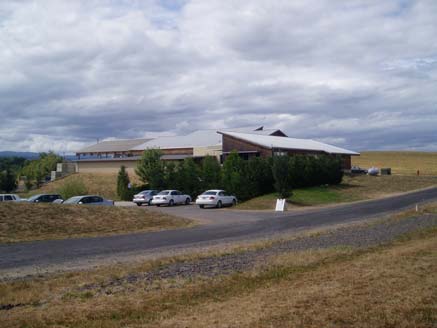 Originally, Eric was committed to aging his wines before release (18 months in barrel and another 18 months in bottle) and he was one of the last to release a vintage Pinot Noir. More recently he has bowed to current winery protocols and has just released the 2006 vintage of his Hamacher Pinot Noir. Eric sources fruit from up to twelve different vineyards for the single Pinot Noir he produces under the Hamacher label. A value-priced Pinot Noir from declassified fruit is released under the H label.
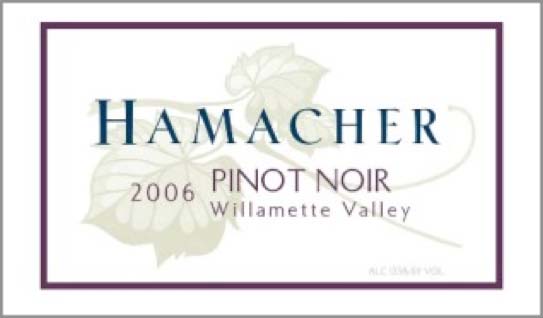 2005 Hamacher Willamette Valley Pinot Noir 13.5% alc., $37. · Subdued, but pleasant scents of red fruits, Jolly Rancher red, and herbs. Restrained and elegant stylistically with a graceful core of darker red berries and cherries and a deft touch of oak. Soft and silky and very round with a finish that fades gently over time. A pristine Pinot of great charm.
2007 Hamacher Williamette Valley Rosé 13.1% alc., $17. · Attractive copper colored wine. Good body and snap, with generous flavors of tropical fruits, watermelon and persimmon.
Hamacher Wines are distributed through fine retail stores and sold on the website at www.hamacherwines.com. The wines are available for tasting daily at the Carlton Winemaker’s Studio, located at 801 N Scott St, in Carlton (www.carltonwinemakersstudio.com).
A very small (2,000 cases) producer of vineyard-designate wines established in 1999 and located in West Linn, just north of Corvallis. The three vineyard sources include: Le Pavillon Vineyard located in the Dundee Hills with vines over 30 years old, farmed organically since 1999 and biodynamically since 2005; La Chenaie Vineyard in the Eola-Amity Hills appellation currently transitioning to organic farming; the estate Meute de Chiens Vineyard in West Linn planted to six clones of Pinot Noir and farmed organically. The top cuvees are offered under the Holloran label and are crafted by noted winemaker Jay Christopher Somers (formerly Cameron Winery and now with his own label, J. Christopher Wines) with assistance from Mark LaGasse. Winemaking is traditional with minimal handling, small lot fermentations, no fining or filtering. A second, value-priced line of wines is bottled under the Stafford Hill label.
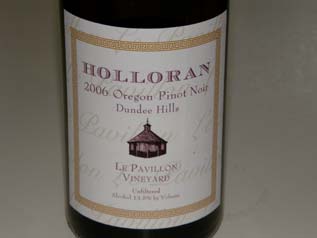 2006 Holloran Le Pavillon Vineyard Dundee Hills Willamette Valley Pinot Noir 13.5% alc., $33. · Not a terribly deep or complex wine, but one that has admirable finesse and easy drinkability. Plenty of black cherry and black raspberry fruit to satisfy with a hint of oak spice and char. Soft, clean and nicely balanced. Similarly styled to Jay Christopher’s own wines, this one is impressive for the money and worth seeking out.
Holloran Vineyard wines have good retail distribution on the East and West coasts. The website offers little information at www.holloranvineyardwines.com. The phone is 503-638-6224.
Lynn and Ron Penner- Ash craft their Pinot Noirs in a newly constructed gravity flow winery located on 80 acres in Newberg, OR. Lynn attended University of California Davis, switching majors twice, changing from botany to viticulture and then to enology before she found her chosen career path. After graduation, she started out as an enologist for Stag’s Leap Wine Cellars. Four years later, she was off to Oregon and became the winemaker at Rex Hill Winery in 1988. In partnership with her husband, Ron Penner-Ash, she started her own label in 1998 while still at Rex Hill. She made the first Penner-Ash wines at Carlton Winemaker’s Studio. In 2001 she and her husband decided to devote all of their energies to developing their own brand and she left Rex Hill in 2002. She has a touch with Pinot Noir and her wines have received well-deserved praise from the wine press. Ron has left his teaching career behind and is involved in the winery’s vineyard management and marketing. The lineup of Penner-Ash Pinot Noirs includes a Willamette Valley appellation blend, Shea Vineyard Pinot Noir, Dussin Vineyard Pinot Noir, Goldschmidt Vineyard Pinot Noir, Seven Springs Vineyard Pinot Noir and a Pinot Noir/Syrah blend labeled Rubeo. The wines (also including Syrah and Viognier) are sold on the website and through retail channels. Total production is 6,000 cases.
2006 Penner-Ash Wine Cellars Willamette Valley Pinot Noir 14.5% alc., 4,500 cases, $48. From different vineyards in the northern part of the Willamette Valley. · Shy, but charming dark red fruits and a sniff of spice that builds in intensity in the glass. A bit reticent black cherry core with a sidecar of cola and grilled meat, plenty of unresolved tannins, and a little heat on the finish. Just not together right now.
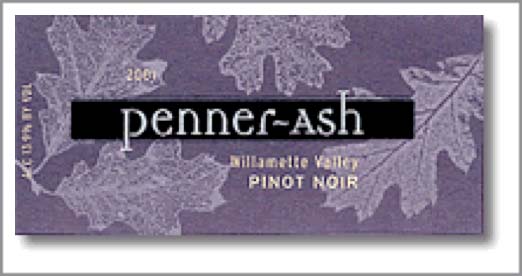 2006 Penner-Ash Dussin Vineyard Willamette Valley Pinot Noir 14.5% alc., $60. Penner-Ash is surrounded by the Dussin Vineyard located high on a ridge in the Yamhill-Carlton District. Chris and Tyanne Dussin are the owners. · The wine sports darker Pinot fruits in the nose and the fruit is echoed in the flavors. A beautiful wine which is full, plush and creamy in the mouth displaying deft use of oak and a refreshing and lingering finish. Still a bit shy, the wine picks up intensity and complexity in the glass over time. I would give this one a couple of years in the cellar, but it will be tough to avoid the temptation to open it now.
Penner-Ash Wine Cellars wines are sold on the website at www.pennerash.com and through retail channels. A tasting room is located at the winery, 15771 NE Ribbon Ridge Rd in Newberg. Call for hours (503-554-5545).
Mark and Tina Hammond hand craft their Pinot Noirs from two acres of vines planted on their estate on Chehalem Mountain. He is the steward of the vineyard and she makes the wines. This division of labor is convenient because Mark can blame Tina and visa-versa if there is a problem with the outcome of the finished wine. They bottle three wines, Le Sud from the South 1 acre, Le Nord from the North 1 acre, and Joie de Vivre, a reserve. Quantities are miniscule and demand is high. Privé (‘private’) Vineyard is probably Oregon’s smallest winery at 250 cases. Certainly it is among the most exclusive. The Pinot Noirs made here are highly sought after, but with such a small production, all the wine is currently allocated to a full mailing list (you can ask to placed on a waiting list, but as accommodating as the Hammonds are, begging will not work). Remarkably, the first vintage (2001) sold out in six months, the second in two weeks. Now everything is sold on futures.
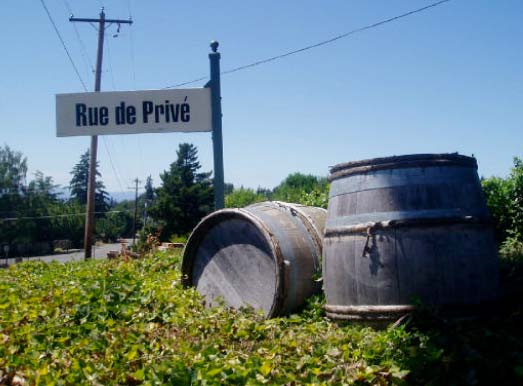 This estate vineyard was first planted in 1980. When the Hammonds bought the property on Chehalem Mountain, the house was run-down and the vineyard neglected. In 1995, they took cuttings from Patricia Green at Autumn Wind and grafted the now twenty-five-year-old Müller-Thurgau vines (a cross of either Riesling and Sylvaner or two strains of Riesling) over to Pinot Noir (100% Pommard). 95% of the grafts took, and later vines were re-grafted that did not take initially. Precision viticulture is practiced here, made possible by the small size of the vineyard. Mark pulls off secondary clusters which pull energy from the vine, so that there is one cluster per shoot. Usually he leaves the lower cluster unless the top is healthier. Yields are 1' to 2 tons per acre. He uses organic sulfur aggressively every week starting in the spring to ward off mildew. Gradually, he tapers to every three weeks, and stops spraying on August 1. The vineyard is LIVE certified but not organic as they use Roundup to control weeds (the only inorganic chemical used). Experienced pickers are hired at harvest, but otherwise this is truly a family run estate. Tina is a talented self-taught winemaker who has a knack for making Pinot Noir with heavenly balance. Women winemakers may have a special talent for this. David Westrey, of Westrey Wines in McMinnville, Oregon has said, “Women show a sense of balance in winemaking that you don't see with men.” The grapes are 100% de- stemmed. No crush is employed to retain the maximum number of whole berries. The grapes are meticulously sorted, placed in 1 ton plastic fermentation bins, and allowed to cold soak for an average of 4-5 days. Le nord sees 15% new oak and 1, 2 and 3 year-old barrels. Le sud, from the lower block, is aged in 100% new French oak. It is a more cellar-worthy wine. A reserve, labeled Joie de Vivre ('joy of life') is made in limited amounts. Whichever direction you turn, Nord or Sud, there is an elusive kind of romance waiting. There is a lot to be said about both the art and science of winemaking. The Hammonds obviously studied their trade in depth through travels to Burgundy and basic wine science courses taught in nearby Salem. However, there is the work of artists evident here that shows through in the charm of these Pinot Noirs. The Hammonds are quite humble about their success to date. Their business model is such that a really bad vintage could severely hamper their dreams. Tina likes to joke, “Mark will have to get a real job.” They kid each other about what each one would do. Mark thinks he might pump gas because he has always dreamed of this outdoor job. Now that is real humility.
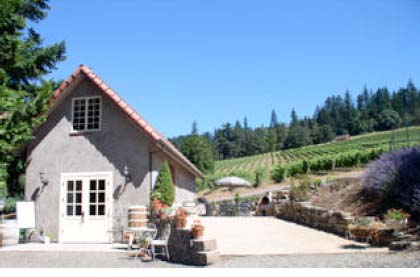
2005 Privé Vineyard le nord Yamhill County Willamette Valley Pinot Noir 13.4% alc., $42. · Unusual aromas of exotic woods, cedar, pine, solvent and vegetable garden. Reticent fruit on the palate with cherry notes, savory herbs, and the solvent note. The tannins are silky and the wine is balanced but fails to deliver the flavor profile usually offered in wines from this vineyard.
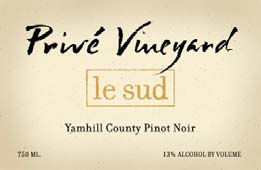 2005 Privé Vineyard le sud Yamhill County Willamette Valley Pinot Noir 13.4% alc., $50. · Fresh fruit on the nose with a subtle oak and medicinal note. Ripe darker fruit favors with a touch of forest floor and smoke. All silk and satin and sporting a welcoming elegance.
2006 Privé Vineyard le nord Yamhill County Willamette Valley Pinot Noir 13.0% alc., $45. · Charming scents of spiced cherries, wildflowers, vanilla and chocolate. Plenty of earth-dusted black cherry and plum fruit enhanced with subtle oak. Smooth and satisfying, seamless throughout, with a touch of tangerine peel on the finish.
2006 Privé Vineyard le sud Yamhill County Willamette Valley Pinot Noir 13.4% alc., $53. · Cinnamon spiced red cherries, oak and cedar, and a heart-stopping floral perfume. Merci! Delicate red fruit spiced to the hilt that caresses the tongue and coats the mouth. Clean, pure, demure and refreshing. A complete wine of impeccable balance and special breeding. Cancel the spouse's Nordstrom credit card, put the kids in public school, buy a hybrid, sell your California Cabs that are gathering dust, eat at home, and buy as much of this that you can get your hands on.
Privé Vineyard Pinot Noirs are sold exclusively as futures through a mailing list which is now full. Occasionally bottles show up on the secondary market. The website is www.privevineyard.com and the phone is 503-554-0464. Please do not contact Privé with unrealistic expectations for there just isn’t any wine available. If the opportunity arises, the Hammonds plan to add to their vineyard holdings and production would increase modestly. The 2005 vintage Pinot Noirs are not as pleasing to me as I have come to expect from Privé, at least as tasted at this time. The important lesson here is that not all vintages are the same and you have to be loyal to a producer, accepting their best effort each year. Remember, each vintage is a different song, but the composer is the same.
Kevin and Carla Chambers farm the 20-acre Resonance Vineyard biodynamically (Demeter certified) and make the wine at Carlton Winemaker's Studio under the corporate name of Reed & Reynolds. For nearly 20 years, the Chambers sold all of their grapes to other wineries, but starting with the 2006 vintage, they held back 14 tons of Pinot Noir and started producing wine under their own label. They plan to keep about half their production for their own Resonance Vineyard label and sell the other half to winemaker Peter Rosback of Sineann. Kevin and Carla own Oregon Vineyard Supply and Results Partners, a vineyard management and development company that farms over 800 acres of vineyards in the northern Willamette Valley. Kevin was named Oregon Wine Industry Man of the year in 2005. The Resonance Vineyard is located on a south-facing hillside in the Yamhill-Carlton District AVA. The entire site is dry-farmed. The Biodynamic® certification by Demeter encompasses the entire 32-acre farm. The Chambers craft a 150-ton organic compost pile every other year for ground application. The vines are virtually all own-rooted and the oldest blocks are 26 years of age.
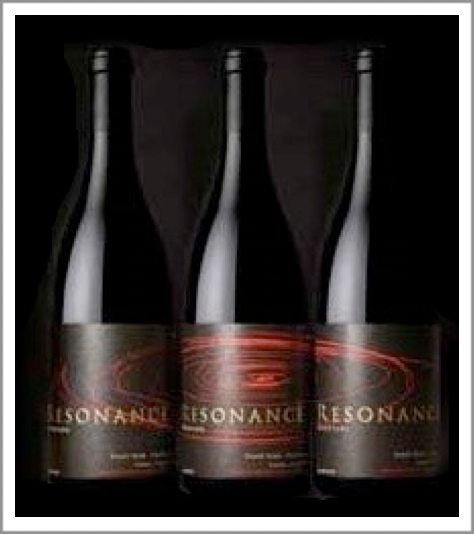 2006 Resonance Vineyard Yamhill-Carlton District Willamette Valley Pinot Noir 13.8% alc., $49, glass “Vino-Seal” stopper. The clonal mixture is Dijon 777, Pommard, and Wädenswil (about a third of each). The Pinot Noir was co-fermented with Gewürztraminer, also from Resonance Vineyard, to heighten aroma and spice complexity. Fermentation was carried out with natural yeasts and water was added to reduce the potential alcohol (natural grape sugars were as high as 27.5° Brix). Aging progressed in two-thirds new French oak. The wine was produced according to biodynamic standards. · A full-scented nose of black cherries and strawberries with a hint of herbs and mocha. The flavors echo the aromas. A dancing Pinot that is light on its feet and supple in the mouth. The tannins are powdery and the sweet fruit leaves a memorable aromatic scent at the finish. This is one you will want to spend the night with.
Resonance Pinot Noir is sold through retail distribution and on the website at www.resonancevineyard.com. Visit the very informative website for more information. 503-437-4212.
This is a relatively new producer in the Willamette Valley named for the four daughters of proprietors Steve and Paula Black. The inaugural vintage was 2003. The wines are sourced from the family's 54-acre vineyard in the Dundee Hills AVA. This vineyard will soon receive LIVE credentials. Pinot Noir clones planted here are 113, 114, 115, 777, Pommard and Wädenswil. A second vineyard, Doe Ridge, located in the Yamhill-Carlton AVA, was purchased and replanted in 2005 by the Black family and will see its first full harvest in 2008. The Doe Ridge Vineyard is unique in that it consists of two 20-acre parcels divided by a canyon, with one parcel farmed biodynamically and the other one farmed according to LIVE guidelines. It will be interesting in the future to compare the wines that originate from the two parallel portions of the same vineyard. The winery's consulting winemaker is Laurent Montalieu.
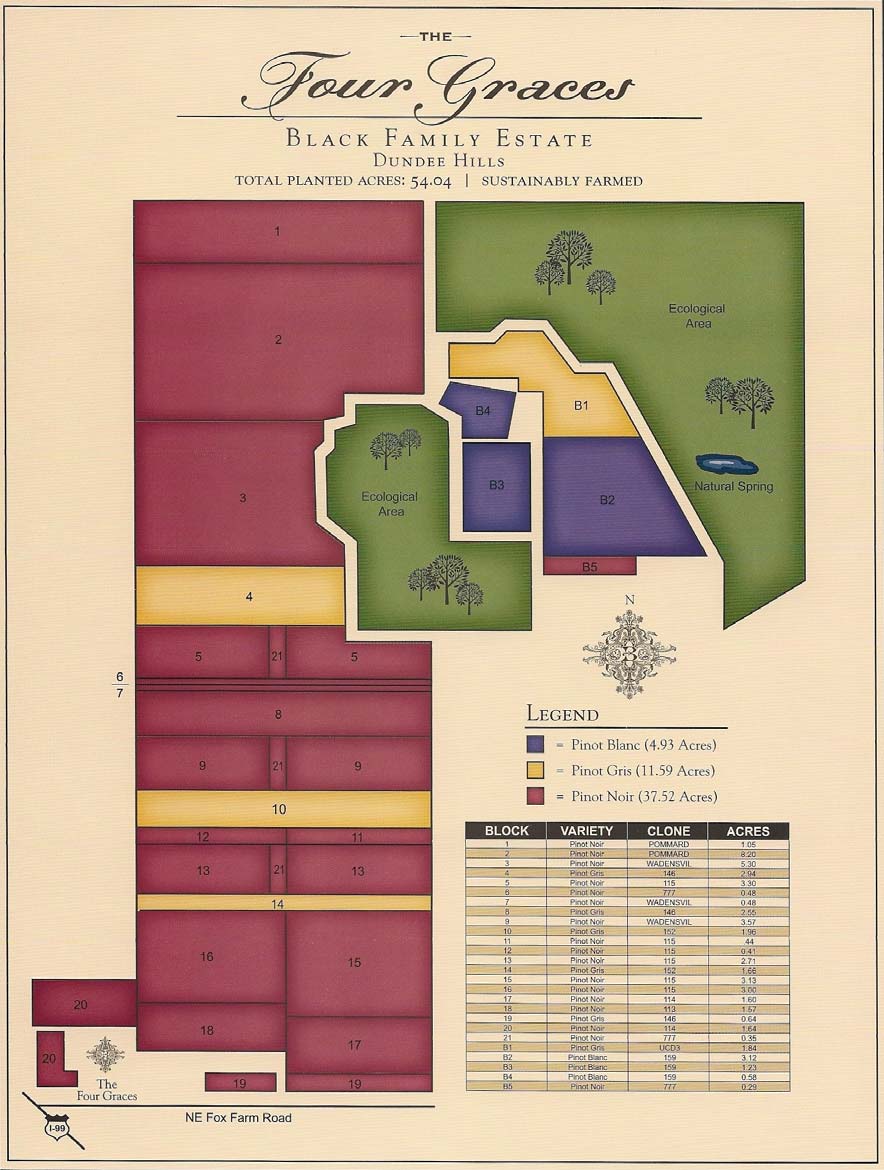 I tasted through the latest releases from The Four Graces and was impressed by all three wines. They are very well crafted and worth a serious look.
2006 The Four Graces Estate Willamette Valley Pinot Noir 13.9% alc., 7,400 cases, $27. Aged 10 months in 30% new French oak. · Aromas of oak char, grass and forest floor dominant the ripe dark red fruits present. Cherry and berry flavors are quite juicy and accented by toast and a hint of spice. The wine is very smooth on the palate with silky tannins and a pristine finish. A warm and fuzzy wine.
2006 The Four Graces Estate Reserve Dundee Hills Willamette Valley Pinot Noir 14.2% alc., 2,755 cases, $42. Aged 13 months in 46% new French oak and an additional 7 months in bottle before release. · The aromas of Bing cherry, cedar and vanilla draw you to the glass. There is the slightest hint of alcohol on the nose. Succulent hi-tone red fruits, especially raspberry, set off by brown sugar and dark chocolate notes, are soft, seamless and comforting. Definitely worthy of a “Reserve” designation. Pinot Geek wanted to drink the whole bottle.
2005 The Four Graces Black Family Estate Dundee Hills Willamette Valley Pinot Noir 14.5% alc., 400 cases, $75. Blended from the best barrels. Unfined and unfiltered. Primarily clone 115 grapes were fermented with proprietary yeast. Aged in 46% new oak barrels for 9 months and an additional 2 years in bottle before release. · This wine is quite dark in color, veering toward dark violet and brimming with scents of crushed black cherries and vanilla. High-collared dark stone fruit flavors are discreetly concentrated so that the wine is plush but still light on its feet. An appealing earthiness and smoke add to the intrigue with a silky smooth texture and a tangy, dry finish completing the package.
The Four Graces wines are distributed nationally and are available at www.thefourgraces.com. The winery's tasting room, located at 9605 NE Fox Farm Road in Dundee is open daily from 10-5. 503-554-0632.
Amy Wesselman may be best known as the long time Executive Director of the annual International Pinot Noir Celebration in McMinnville, Oregon (2008 was her last year of leadership), but she is also a terrific winemaker. Together with co-winemaker David Autrey, the two founded Westrey Wine Company in 1993. The name Westrey comes from their collaborative winemaking effort (Amy WESselman and David AuTREY). Each has had extensive winemaking experience (Amy at Oregon's Bethel Heights, Rex Hill and The Eyrie Vineyards and Burgundy's Domaine de L'Arlot; David at Oregon's Adelsheim, Cameron and Burgundy's Domaine Dujac). The two met while studying philosophy at Reed College in Portland and their philosophy of winemaking is nicely summed up in their tag line: “Texture and terroir amidst post industrial splendor.” Initially Westrey owned no vineyards, sourcing grapes from some of Oregon's top vineyards including Croft, Abbey Ridge, Bethel Heights, Temperance Hill, Anderson Family and Laurel Hood. In 2002, they bought about 50 acres in Yamhill County next to Abbey Ridge Vineyard and planted 5 acres to vines. This was advantageous for they had worked with Abbey Ridge Vineyard fruit for several years. Starting with 400 cases in 1993, Westrey currently produces around 3,200 cases in a small winery in McMinnville, with a goal of reaching 6,000 to 8,000 cases over the next ten years. In their winemaking, new oak is kept to a minimum for Pinot Noir and Chardonnay. The Alsatian-inspired Pinot Gris sees no oak or MLF. Their style is a departure from many Oregon producers with more emphasis on structure, texture and aging potential. To that end, their wines tend to have higher acidity, a nod to their Burgundian training.
2006 Westrey Oracle Vineyard Dundee Hills Willamette Valley Pinot Noir 13.5% alc., $25. · A charming wine of great complexity that has a heart of red cherry complimented by baking spices, strawberries, and vanilla. Just delicious, with great purity of fruit, slippery tannins, and a clean and dry finish.
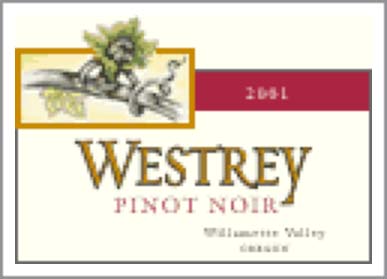 2005 Westrey Reserve Willamette Valley Pinot Noir 13.5% alc., $30. · The finest barrels from each lot blended into a limited cuvee. Similar to the Oracle Vineyard bottling but richer and more reticent. Aromas of cherries, herbs, hay and oak build in intensity with time in the glass. The fruits are dark and substantial but the wine retains admirable finesse. There are still some tannins to shed but when this one reaches its apex in a few years, it will be one heck of a celebration.
2006 Westrey Abbey Ridge Vineyard Dundee Hills Willamette Valley Pinot Noir 13.5% alc., $36. · This seemed to be an off bottle and not consistent with other Westrey offerings this vintage. The nose offered cranberry, orange peel and a hint of volatile acidity. Earthy, with black raspberry jam and rhubarb flavors with echoes of oak and a citrus overlay.
Westrey Wine Company is located at 1065 NE Alpine St, McMinnville. The website is www.westrey.com and the phone is 503-434-6357. The wines, including older vintages are sold through retail channels. Prices are very sensible, ranging from $18 to $36. I am sure Amy or David would be happy to have you taste by appointment.
Jim Bernau (pictured right) founded Willamette Valley Vineyards in the southern Salem hills in
1983, planting Pinot Noir, Pinot Gris and Chardonnay in the central Willamette Valley in
Turner, Oregon. A home winemaker and small business lobbyist at Oregon's State Capital,
he cleared the blackberry vines and remnants of a plum orchard himself and remembers
watering the fledgling vines with a garden hose by hand. Initially he sold his grapes to Dick
Erath. The winery quickly grew into Oregon's leading producer of wines selling at $15 and
above only three years after its first release of Pinot Noir. Today, Willamette Valley Vineyards
is the third largest Oregon Winery by brand and production releasing approximately 111,700
cases of wine each year. About half of the production is Pinot Noir. The winery now has over
4,500 owners, a result of the nation's first successful self underwritten public offering (1989,
Nasdaq WVVI). Jim Bernau was named Purveyor of the Year in 2007 by the Oregon
Restaurant Association for his tireless lobbying for the Oregon hospitality industry.
The Estate Vineyard consists of 50 acres of Pinot Noir planted to Pommard and Wädenswil clones. The winery
and underground cellar are carved into the top of an ancient volcanic flow. In 1997, Willamette Valley
Vineyards acquired Tualatin Estate, near Forest Grove, and plantings there have been increased using new
rootstocks and Dijon clones of Pinot Noir. Both the Estate and Tualatin Vineyards are are certified LIVE and
Salmon Safe.
The current winemaker is Forrest Klaffke, brought in from California by former Willamette Valley Vineyards
winemaker Dean Cox. Forrest was promoted to winemaker several years later after Joe Dobbes, the
winemaker who followed Cox, started his own Oregon winery in late 2001. Forrest has now worked in wineries
for over 28 years. He spends a considerable amount of time attending to every detail in the vineyards.
Vineyard Manager Efren Loeza began his career at Tualatin in 1979 at 17 years of age and has worked in the
vineyard and in the cellar there ever since. Efren lives on the estate in the farmhouse built by the original
owners of the property. He now has nearly 300 acres under his supervision.
This is an innovative and progressive winery. In 2005, they were the first winery to include resveratrol levels on
their wine labels. More recently, they became the first winery to use cork stoppers harvested from forest lands
certified by the Rainforest Alliance to Forest Stewardship Council (FSC). The company has launched a cork
recycling initiative with Amorim and recycles used wine bottles. In the past the winery made its own fuel and
now use bio-fuel from a potato chip plant.
I sampled four 2006 vintage Pinot Noirs from Willamette Valley Vineyards. All the wines had alluring aromatics
and were beautifully balanced. This is a label, despite its large size, you can rely on for consistently fine wines.
The general winemaking regimen for Pinot Noir is as follows. The grapes are de-stemmed with approximately
50% to 70% of the grape berries remaining intact for intra-berry fermentation. A four to five day cold soak of
the must is followed by inoculation with proprietary yeast. Fermentation progresses in small lot .5 ton and 1.5
ton vessels (for the Willamette Valley blend, 10 ton vessels are also used). Hand punch downs of the cap are
employed in the smaller vessels, pneumatage in the 10 ton fermenters. The wine is racked to barrel where it finishes primary fermentation and undergoes MLF. The Willamette Valley blend and the Estate Vineyard
bottling are filtered and the Tualatin Estate and Signature Cuvee are unfined and unfiltered.
2006 Willamette Valley Vineyards Willamette Valley Pinot Noir
14.5%
alc., 25,127 cases, $25. Aged in 20 Allier Forest oak. The clonal mix is
Dijon 113, 114, 115, 667, 777, Pommard and Wädenswil.
·
Appealing
scents of confected red cherries, sen-sen, graham and faint oak. Tasteful
cherry attack on the palate with a touch of spice, marzipan and raisin.
Fairly light in weight, clean and silky, with a tangy finish. Plenty good for
the price and a perfect daily drinker.
2006 Willamette Valley Vineyards Estate Vineyard Willamette Valley Pinot Noir
14.5% alc., 2,534 cases,
$40. Clones are 667, 777 (both grafted in 1993), Pommard and Wädenswil. The vineyard, which was originally
planted in 1983, has 50 acres of vines on Nekia and Jory soils that are well drained. Aged in 35% new oak.
·
Dark cherries, dried herbs and char lead the aromatic charge. A healthy core of black cherry and black
raspberry fruit with a sidecar of savory herbs and oak char. Soft and bright in the mouth with a refreshingly
clean finish.
2006 Willamette Valley Vineyards Tualatin Estate Vineyard Willamette Valley Pinot Noir
14.5% alc., 402
cases, $40. Tualatin Estate Vineyard is one of the oldest vineyard sites in Oregon
·
This is a fascinating wine. The nose offers aromas of cherries, grass and herbs,
primarily sage. Deep, dark, earthy and plush in the mouth, with a panoply of dark stone fruits and a hint of
game and smoke. Plenty of stuffing here but not overwrought and retaining lively acidity at the end. The
tannins are evident (the most tannic wine of the lineup), but are soft and add needed backbone. This wine
would match beautifully with hearty dishes such as lamb, venison and a well-grilled steak.
2006 Willamette Valley Vineyards Signature Cuvee Willamette Valley Pinot Noir
14.5% alc., 321
cases, $50. Clonal mix is 114, 115, 777, Pommard and Wädenswil. Aged in 40% new oak. A limited
bottling produced only in the finest vintages from the finest barrel lots of vineyard-designated Pinot
Noir.
·
This wine is all about black cherries pure and simple although some strawberry and herbal
flavors chime in as well. A very high-class wine with admirable elegance, gossamer tannins and
striking persistence on the finish. Smooth as a baby's bottom.
Willamette Valley Vineyards address is 8800 Enchanted Way, SE, Turner, OR. The phone is 503-588-9463.
The wines are widely distributed in the United States and are sold on the winery's website at
www.willamettevalleyvineyards.com. A tasting room is open from 11-6 daily. Tours are by appointment. The
Willamette Valley appellation blend is consistently a fine value in quality Oregon Pinot Noir. The Tualatin Estate
and Signature Cuvee bottlings are only sold in the tasting room and offered as a benefit to the winery's wine
club (Oregon Wine Guild) members.
The Winderlea (Win-dur-lee) Vineyard was formerly known as the Dundee Hills Vineyard when it was first
planted in 1974 by John and Sally Bauers. It was rechristened Goldschmidt Vineyard after the former Oregon
governor who purchased the property in 1998. Located in the heart of the Dundee Hills adjacent to a portion of
Maresh vineyard and across the street from Le Pavillon Vineyard along Worden Hill Road, this 16.5-acre
vineyard has supplied grapes to some of the Willamette Valley's most prominent wineries including Dusky
Goose, Patricia Green Cellars, Penner-Ash, R. Stuart & Co., and Adelsheim Vineyard.
In 2006, Bill Sweat and Donna Morris left the East Coast for Oregon and the next year bought the Goldschmidt
Vineyard, renaming it Winderlea Vineyard. The name Winderlea is derived from a Vermont property the couple
owned and is a German word loosely translated as “valley protected from the wind.” The husband and wife
team developed a passion for Burgundies in the 1990s and found Oregon Pinot Noir was the next best thing.
They brought on Robert Brittan, the winemaker at Stags Leap Winery for 16 years, to assist Bill and direct the
new Pinot Noir program. Brittan himself bought 128 acres in the Willamette Valley, and plans to craft Pinot Noir
and Syrah under his own label, Brittan Vineyards. A stunning metal and glass tasting room and winery was
built and positioned to take advantage of panoramic views of the Dundee Hills and the Willamette Valley to the
East. As I noted earlier in this issue, during the IPNC, I stayed in a retreat on the Maresh property which is
only a few steps from the Winderlea Vineyard and Winery. The photos are quite striking (below).
For the full story on Winderlea Vineyard, consult the excellent article written by Jean Yates, proprietor of Avalon
Wine, a top source for Oregon Pinot Noir: “Winderlea Vineyard. A Diamond in Oregon Wine's 'Gold Coast,' “ at
www.avalonwine.com/Winderlea-Vineyard.php.
I tasted the two inaugural releases of Winderlea Pinot Noir. Total production was tiny (a total of 575 cases) but
will increase in the future as the owners retain more of their own fruit (according to Jean Yates, only Dusky
Goose and Penner Ash Wine Cellars will still receive grapes after the 2006 vintage). These two wines are very
impressive and this is a producer to latch onto for the future.
2006 Winderlea Vineyard & Winery Dundee Hills Inaugural Reserve Willamette Valley Pinot Noir
14.2%alc., $50. Sourced from the Ana and
Weber vineyards which are located next to Winderlea. These two
vineyards are among the oldest self-rooted Pinot Noir vines in Oregon
dating back to 1976. The clones are primarily Pommard and 777.
·
Lovely
aromatics featuring ripe and deep red fruits that are nicely spiced with a
touch of pear and rose petal. Deep cherry flavors accented with notes of
cocoa and pear. Very smooth and stylish with soft tannins.
2006 Winderlea Vineyard & Winery Goldschmidt Vineyard Dundee Hills Willamette Valley Pinot Noir
14.6% alc., $50. Labeled Goldschmidt Vineyard because the vineyard
was still owned by Neil Goldschmidt in 2006. Clones 115, 667 and 777.
·
Heavily perfumed with deep, dark
fruit, toast, and wild flowers. Dark red berries and cherries carry the theme with a subtle note of graham and
oak, displaying a notable velveteen texture and a slight tart citric note on the pleasing finish.
Winderlea Vineyard & Winery (officially Winderlea Wine Co.) Pinot Noirs are available online at
www.winderlea.com and www.avalonwine.com. A 2006 Winderlea Vineyard & Winery Ana Vineyard Pinot Noir
is also available ($45). The tasting room, which offers panoramic views of the Dundee Hills, is open Memorial
Day through Thanksgiving Weekend, Friday, Saturday and Sunday from 11-4. 503-554-5900.
More Sips of Noiregon PinotThe following wines were sampled over the last two months. There are some real treasures in here. Details on most wineries can be found in the Winery Directory on the Prince of Pinot website.
2006 Cooper Mountain Vineyards Reserve Willamette Valley Pinot Noir 13.5% alc., $24. Certified organic and biodynamic vineyards. · Fairly dark reddish-purple color. The aromas emerge with time in the glass offering plum, blackberry and herbs. Mildly tart berry and cherry fruit flavors on the lean side with a touch of herbs and wood, finishing with a tangy bite. Needs food.
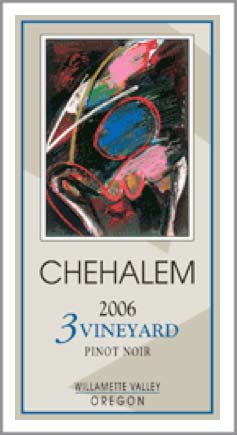 2006 Chehalem 3 Vineyard Willamette Valley Pinot Noir 14.8% alc.,4,053 cases, $32 screw cap. Chehalem (Chuh-hay-lum) is a local Calapooia Indian word best translated as “gentle land” or “valley of flowers.” Chehalem has 260 planted acres on 600 total acres in three AVAS (Chehalem Mountains, Dundee Hills and Ribbon Ridge). Chehalem was launched in 1990 by Harry Peterson-Nedry along with Bill and Cathy Stoller. This wine is the first release of the vintage and is ready to drink. It is sourced from three estate vineyards: Ridgecrest (25%), Stoller (60%), and Corral Creek (15%). Aged 9 months in 25% new, 27% one-use, and 48% multiple-use French barrels. DE filtrated. · Bright confected strawberry and cherry scents similar to a Beaujolais wine. A pleasing core of earth-kissed red fruit which is lightly weighted with a short, dry finish that leaves a little heat in its wake.
2006 Capitello Willamette Valley Pinot Noir 13.5% alc., $34. Crafted by Ray Walsh, a New Zealander who formerly was the winemaker at King Estate in Oregon. He makes his wine in rented space at Territorial Vineyards & Wine Company in Eugene. The wine comes from several vineyard sources. · Stylish scents of ripe dark fruits, barnyard, earth and smoke. The cherry and raspberry flavors are long and tasty if a bit flat with mild drying tannins and a hint of citrus on the back end.
2006 Raptor Ridge Shea Vineyard Yamhill-Carlton District Willamette Valley Pinot Noir 15.1% alc., <480 cases, $37. The name of this producer comes from the 27-acre estate in the Chehalem Mountains that is populated by raptors (birds of prey). · Pleasant and complex perfume of red Pinot fruits, herbs, vegetable garden, vitamins and pears. Earthy and brooding on the palate with flavors of dark cherries and currents and a hint of green tomato. With time in the glass, more red fruits emerge, including red cherries and cranberries. Admirable elegance and balance with the alcohol perfectly integrated.
2006 Adelsheim Elizabeth’s Reserve Willamette Valley Pinot Noir 14.3% alc., $40. A barrel selection from four estate vineyards on Chehalem Mountain and a few barrels from northern Willamette Valley. · Heady perfume of strawberry, cherry and fresh herbs. The restrained flavors echo the nose but don’t deliver the intensity of the aromas. A lighter-styled wine that is quite feminine and smooth. The scent trumps the taste now.
 2006 ROCO Willamette Valley Pinot Noir 14.5% alc., $40, screw cap. A blend of vineyards including winemaker Rollin Soles’ own Wit’s End Vineyard. · Subdued scents of dark red cherries and red licorice which blossom with time in the glass. Delicious cherry and berry fruit that is soft in the mouth with no perceptible tannin, this harmonious wine glides smoothly to a slightly tangy and refreshing finish. The 2005 version of this wine might be a skosh better, but this one has plenty to recommend.
2006 St. Innocent Momtazi Vineyard Willamette Valley Pinot Noir 14.8% alc., 413 cases, $40. The Momtazi Vineyard is located in the McMinnville AVA and is farmed biodynamically. This wine is sourced from three blocks planted in 1999 and 2004. Aged 16 months in 35% new oak. Unfined and unfiltered. · The nose sports bright black cherries, lavender and a hint of alcohol. Dense and dark fruit core with grilled meat and tar, and substantial tannins. A bit disjointed now and reserved, this wine deserves a few years in the cellar but it will always show plenty of alcohol.
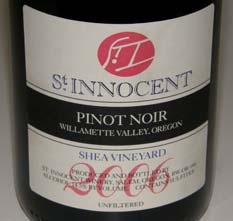 2006 St. Innocent Shea Vineyard Willamette Valley Pinot Noir 14.5% alc., 923 cases, $40. From a block of Shea Vineyard planted in 1990 on shallow Willakenzie soil. Yields 1.9 tons/acre. 100% de-stemmed, 1-2 day cold maceration, fermented in two small tanks, aged 16 months in 35% new French oak, unfined and unfiltered. Mark Vlossek is the winemaker. · Comforting scents of strawberry and raspberry jam with baking spices and herbs. Vigorous flavor and character with oodles of rich, dark red berry and cherry fruit, musk, and raw beef with a healthy tannic backbone and a relatively long finish. Put this one away and forget about it for a few years and you will be rewarded.
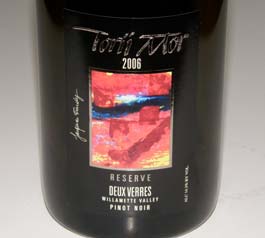 2006 Torii Mor Deux Verres Reserve Willamette Valley Pinot Noir 14.3% alc., 1,000 cases, $40. Select barrels from nine vineyards, mostly in the Dundee Hills (60%), with the rest from the Eola-Amity Hills AVA. ”Deux Verres” means two glasses in French. The artist on the label is Janice Griffin from Portland, Oregon. · A touch of VA blows off revealing lovely scents of ripe cherries, baking spice, cedar and sage. Lovely and elegant in style featuring black cherry and blackberry compote and a deft touch of oak. The well-endowed tannins are smooth and the wine leaves a juicy impression on the finish.
2006 Domaine Drouhin Oregon Willamette Valley Pinot Noir 14.1% alc., $45. · This wine is as different from the 2005 version as night and day. Scents of bright red cherries and strawberries, a veritable “farmer’s market” of summer fruit. Vigorous and open with plenty of raspberry, Chinese 5 spice and subtle oak char flavor. Still young and a tad tight, but it would be hard to keep your hands off this one now. A flat-out beautiful wine. (The 2005 DDO Laurene has just been released).
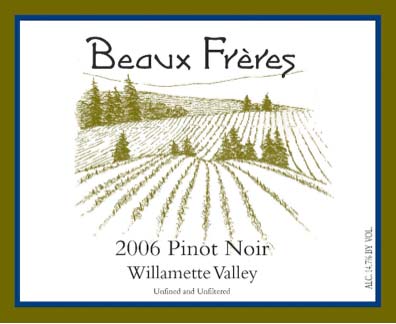 2006 Beaux Frères Willamette Valley Pinot Noir 14.7% alc., $50. A blend of Carabella Vineyard(29%), Shea Vineyard (26%), Zena Heights Vineyard (20%), Amelie Robert (17%) and Ana (8%). · Rich and deep dark cherry and berry fruits nicely spiced and oaked with savory herbs leaping out. Moderately light-bodied with a sexy silkiness and lively acidity providing zip and zing. A very well crafted wine that offers the Beaux Frères experience for 2/3 the price of the estate bottling. I thought I could taste a little savory Parker in the wine.
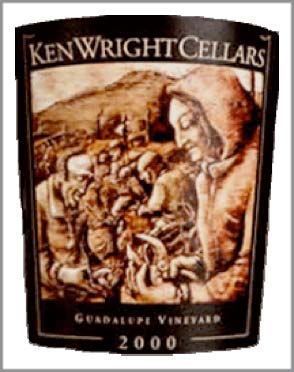 2006 Ken Wright Cellars Abbott Claim Vineyard Yamhill-Carlton District Willamette Valley Pinot Noir 13.5% alc., $50. This vineyard is on a ridge line on the east side of the Yamhill-Carlton district and is owned by Ken and Karen Wright. Mark Gould manages the vineyard. The label on Ken Wright wines pays homage to field workers depicting the practice of pruning. · Darker fruit aromas are dominated by toasted oak and dried herbs. Both red and black earth-dusted fruits are teasing now but the wine is brooding and reticent. Beautifully balanced with moderate tannins that need softening. Great stuffing here, but this wine needs a couple of years to flesh out.
2006 Torii Mor Dundee Hills Select Willamette Valley Pinot Noir 14.3% alc., 425 cases, $50. Composed of special barrels chosen by winemaker Jacques Tardy. 50% La Colina Vineyard, 23% Olson Estate Vineyard and 26% Bella Vida Vineyard. · The nose is clamped shut offering a touch of red berry fruit and spearmint scents. Welcoming wild berry flavors are complimented by a nice touch of oak and a citric tang on the lively finish. Smoothly textured. The fruit is still quite reticent assuring this wine won’t win any beauty contests now, but it definitely has plenty of allure that will emerge down the road.
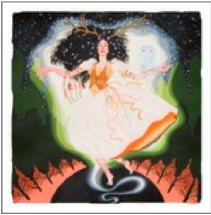 2006 Lost Highway Project Willamette Valley Pinot Noir 14.5% alc, 150 cases, $55. A special release from Bergström Wines sourced from three vineyards: Nysa 1/3, Bergström 1/3, and de Lancellotti 1/3. Produced in conjunction with Vine Street Imports (VSI), an importer of fine wine that collaborates with winemakers to create original and exclusive bottlings with labels designed by internationally acclaimed artists. Beginning in 2002, a unique wine has been released each year by VSI. · Very dark reddish-purple color. Inviting dark themed nose of blackberry jam, chocolate and mocha. Plush, rich, and darkly fruited with subtle oak and forest floor accents. A powerful wine that needs time to assimilate the substantial tannins, but it will always be a glamazon.
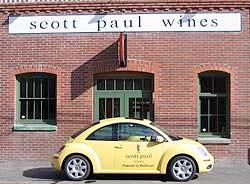 2006 Scott Paul Audrey Dundee Hills Willamette Valley Pinot Noir 13.5% alc., $55 (sold out). This is the top bottling from Scott Paul, a special cuvee of the best barrels in the cellar. Named after Audrey Hepburn. · A “Burgundian” nose of deep red fruits, cinnamon, cardamon, and barnyard. Big and serious, the dark fruit core is all crushed silk. Still simple and closed, with a touch of alcohol peeking out on the nose and finish. Not ready for prime time and patience will be rewarded.
2006 Brick House Evelyn’s Ribbon Ridge Willamette Valley Pinot Noir 14.0% alc., $59. Brick House’s vineyards have been certified organic since 1990 and Demeter certified biodynamic since 2005. · The nose is unsettling, taking me back to my days in the operating room. It has that hospital ward or operating room aroma with very little fruit showing up. A big and brooding wine with copious cherry and strawberry fruit and plenty of tannin on a mildly hot finish. This wine should be cellared. It is likely this was a bum bottle.
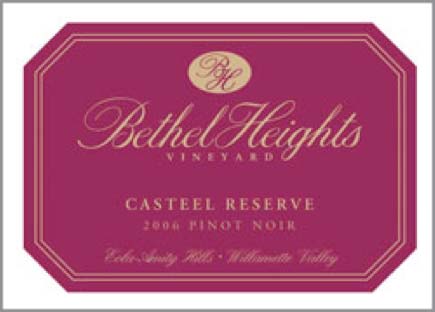 2006 Bethel Heights Vineyard Casteel Reserve Eola-Amity Hills Willamette Valley Pinot Noir 14.8% alc., $60. From a LIVE and Salmon Safe vineyard (see feature on sustainability in this issue). · A beautiful wine of great style and sensuality. Demure scents of Bing cherry, black raspberry, baking spice and forest floor. Long and smooth flavors duplicate the aromas with an appealing earthiness. Full in the mouth showing a deft use of oak and finishing with a dusting of finegrained tannin. Balanced, gorgeous and pure. Give this wine another year for a hair-raising experience.
2006 Bergström Winery Shea Vineyard Yamhill-Carlton District Willamette Valley Pinot Noir 14.2% alc., 760 cases, $65. A barrel selection from the East Hill portion of Shea Vineyard. Clones 115, 777, 828 and Wädenswil. · Leads off with dark fruits, a hint of spice, sandalwood and alcohol. A big and weighty muscular style with thick earth, wood, tar, char, mushroom and black stone fruit flavors. Smooth in texture with wellcorralled tannins and a mildly dry finish. This wine makes a statement but I am not totally receptive to this big style. Hearty food would tame the wine now, but cellaring the wine a few years would be preferable.
2005 Belle Pente Belle Pente Vineyard Yamhill-Carlton District Willamette Valley Pinot Noir 13.3% alc., $34. A densely planted vineyard established in 1994. Indigenous yeast, 18 months in oak, no fining or filtration. · A fruited nose of black cherry backed by oak spice, herbs and oiled timber. Oak-infused black cherry and blackberry flavors with a lengthy finish marked by brisk acidity and a citric tang.
2005 Scott Paul Le Paulée Willamette Valley Pinot Noir 13.5% alc., $35. This wine is assembled from the best lots of the vintage including blocks of Ribbon Ridge, Shea and Stoller vineyards. Demure aromas of cherry, wet oak and tobacco. · Cranberry and tart cherry flavors with savory herbs and a touch of orange zest. Light and elegant with a healthy acid spine.
2005 Sineann Lachini Vineyard Willamette Valley Pinot Noir 13.6% alc., $37. · Complex and alluring aromas of cherries, exotic woods, vanillin, and caramel. Dark red cherries, sassafras, and oak spice flavors with significant drying tannins which dominate the fruit now. The finish is a touch sour. This wine still needs time to soften the tannins but they will always be prominent.
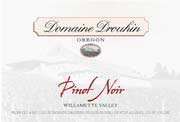 2005 Domaine Drouhin Oregon Willamette Valley Pinot Noir 13.9% alc., $45. This winery represents the first Burgundian presence in Oregon, begun in 1987 by Maison Joseph Drouhin. The 225 acre estate in the Dundee Hills is under the leadership of fourth generation winemaker, Veronique Drouhin-Boss. · Caution: this wine takes at least 30 minutes to come together after popping the cork, but even then it is a tight and stubborn wine that needs more time. Plenty of herbs, hay, and marzipan on the nose. Tart cherry compote which reluctantly reveals its charms accentuated by earth, herbs and oak. Silky and seamless. Like the Dark Knight, suave but sinister.
2005 White Rose Vineyard Quotee’s Lair Dundee Hills Willamette Valley Pinot Noir 13.2% alc., $50. · Cherry syrup, oak char and spearmint aromas lead to pleasant black cherry flavors set off by toasted oak. Some stems flavors intrude. There is plenty of bright acidity producing a tart citric finish.
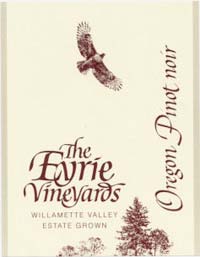 2002 The Eyrie Vineyards Reserve Estate Grown Willamette Valley Pinot Noir 13.0% alc., $50. The Eyrie Vineyards was established in 1966 and is the oldest continuous producer of vinifera wines in the Willamette Valley. Founder David Lett recently retired after 37 vintages. His last vintage was 2004, with son Jason Lett taking over the management of the winery beginning in 2005. The Reserve wines are typically released several years after the vintage. · This delicately crimson-colored wine sneaks up on you. At first pass it seems light and acidic, but it grows on you as it expands and evolves in the glass. The nose is quite shy, offering tart cherries and dried herb aromas. Very light and lean on the palate, the red fruits are backed by baking spices, roasted nuts and savory garden herbs. A distinctive style that won’t appeal to those who prefer bold and fruity Pinot Noirs.
Memorable Winery VisitsNo trip to Oregon is complete without some visits with old friends and new acquaintances. I managed to squeeze in several memorable wine tasting soirees with several of my friends tagging along. Shea Wine Cellars, Anam Cara Cellars, Laura Volkman, and Ponzi Vineyards were all extremely cordial and left me with many wonderful Pinot memories.
Shea Vineyard now consists of 200 hillside acres, of which 140 acres are planted to Pinot Noir and 5 acres to Chardonnay. The vineyard faces south at an elevation of 320 to 625 feet and is divided into two hills, named East Hill and West Hill separated by a valley containing native plants and trees. The original vines of Pommard and Wädenswil clones were planted on their own roots. Inevitably, phylloxera afflicted the vineyard and planned replanting progressed over the ensuing years, reaching completion in 2005. The newer plantings include the Dijon clones 114, 115, 777 and 828. The vineyard has never been irrigated except for new plantings during the first year. Grapes from this impeccably maintained site are highly sought after by many of Oregon’s top wineries including: Andres’s Vat, Antica Terra, Beaux Freres, Bergstrom, Broadley, Elk Cove, Francis Tannahill, J.K. Carrier, Ken Wright Cellars, Panther Creek Cellars, Penner-Ash, Raptor Ridge, Revana, Stevenson- Barrie, Scott Paul Wines, St. Innocent and Torii Mor. In the past, grapes were sent to Manfred Krankl at Sine Qua Non in California (last vintage 2003), but now grapes destined for California go to Loring Wine Co., Pali Wine Co., Auteur and Roessler.
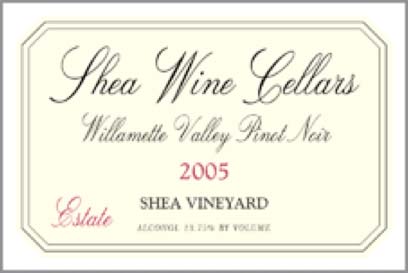 Since 1996, Dick has had his own label, Shea Wine Cellars. 25% of the vineyard production is held back for Dick’s own label. The rest of the vineyard output is sold by the acre, usually cropping 2-2.5 tons per acre. There have been several winemakers for Shea Wine Cellars. Experienced tasters have talked about a certain “Shea-ness” that seems to be expressed in the wines from this vineyard. A consistent floral aroma and a dark red fruit character with spice seems unusually clear and unique to this vineyard. The Shea Wine Cellars Pinot Noirs are designated as Estate (a blend of several blocks), block or clone designates which vary from year to year, and a special reserve wine labeled “Homer.” Dick Shea is a baseball fan, but bears no relation to Shea Stadium in New York. Dick’s spouse and business partner, Diedre Shea. often compares Dick to Homer Simpson, so the name “Homer” has dual meaning. The Homer cuvee is from the best barrels and is the most voluptuous of the lineup, needing several years to reach its prime drinking window. When I visited Dick and Diedre and their new winemaker, Drew Voit, at their winery at Shea Vineyard, we all sat down and tasted through a vertical of Shea Wine Cellars Homer. Dick, himself, had never done this, so it was a special treat for him as well as for me. The Homer release is a blend of the best barrels in the Shea cellar and is intended to have good longevity. The wine is aged in 75%-80% new oak. 250-300 cases are produced each year using primarily clones 115, 777 and 2A and occasionally Pommard. Photo below (left to right, Prince, Drew, Dick, and Diedre).
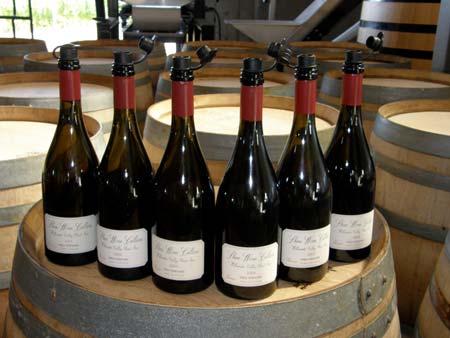 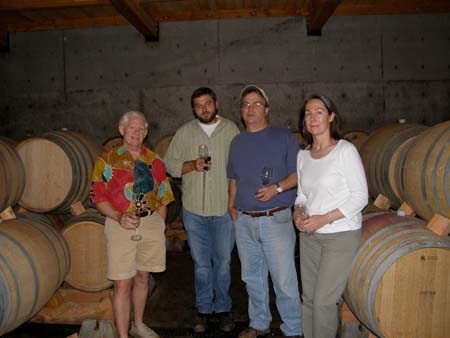 All the wines had intense color with 2005 being the darkest. Dick believes that the leaf pulling he employs in his vineyard toughens and thickens the skins leading to less mildew and more color and flavor. There is significant vintage variability which is further influenced by winemaker differences. These are big fruit-driven Pinot Noirs but not jammy or overwrought.
2001 Shea Wine Cellars Homer Shea Vineyard Willamette Valley Pinot Noir 14.0% alc., 140 cases, $65. Winemaker Patricia Green. A light year and the wine was accessible early. · Tart black cherry and cranberry fruit with a sidecar of oak and cedar. Light in weight and easily drinkable with a mildly dry and woody finish.
2002 Shea Wine Cellars Homer Shea Vineyard Willamette Valley Pinot Noir 14.2% alc, $65. Dick calls this a “great vintage.” Winemaker Sam Tannahill (2002-2004). · Darkly fruited nose with earth and oak chiming in. Brambly dark fruits on the palate with residual tannins. Enough acidity and tannin to last. A good drink.
2003 Shea Wine Cellars Homer Shea Vineyard Willamette Valley Pinot Noir 14.9% alc., 145 cases, $65. A very hot vintage. making it difficult to reign in alcohols. · Lovely scents of Bing cherry, violets, exotic woods and char. Rich and juicy palate of black cherries with velvety tannins and an appealing roundness in the mouth. Subtle oak runs through and adds interest. No hint of over ripeness as one would anticipate.
2004 Shea Wine Cellars Homer Shea Vineyard Willamette Valley Pinot Noir 14.5% alc., $75. “Vintage of the decade” according to Dick. · Appealing minerality, earthiness and charcoal embracing the rich dark fruits. Saucy, fat and lush with velvety tannins and a long, long finish. A seamless wine of great charm and clearly the star of this vertical tasting. That said, the 2005 and 2006 vintages should surpass it in years to come.
2005 Shea Wine Cellars Homer Shea Vineyard Willamette Valley Pinot Noir 14.25% alc., $75. Winemaker Chris Mazepink (2005-2006). A moderate vintage with rain at harvest. · Fruity and floral scents with delicious black raspberry flavor and a tangy finish. A little smoke on water is evident in this and the 2006 vintage due to cooperage choices. More acidity this vintage. There are still some well-integrated tannins to shed and this will continue to improve in the bottle. Great verve.
2006 Shea Wine Cellars Homer Shea Vineyard Willamette Valley Pinot Noir 14.75% alc., $75. · A precocious wine that is highly aromatic featuring black cherries, raisin, mocha and herbs. Intense and lush chocolate-covered black cherry fruit that lasts and lasts on the finish. Excellent now but still showing primary fruit and will get even better in a couple of years.
Before departing, winemaker Drew Voit offered some barrel samples of the 2007 vintage, the first to be vinified in the new winery (photo below). The 2007 Estate was blessed with tremendous raspberry and cherry fruit. The 2007 East Hill was darker and more brooding with reticent fruit and big tannins making it hard to approach. Shea Wine Cellars Pinot Noir and Chardonnay are sold primarily through a mailing list. The website is www.sheawinecellars.com. The winery is not open to the public at this time.
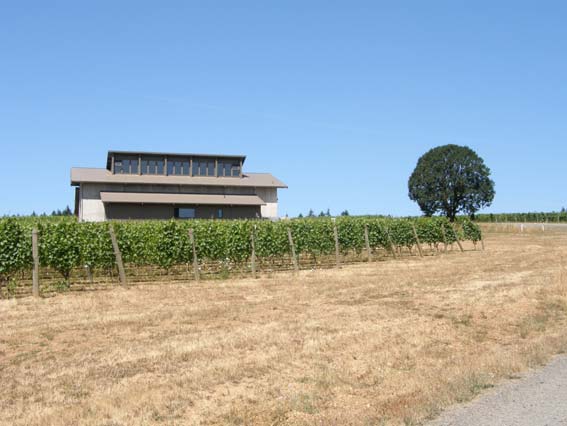
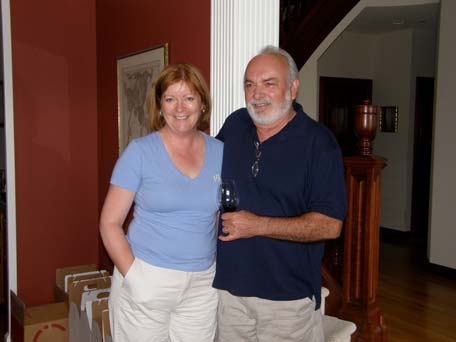 Nick and Sheila Nicholas farm a 30-acre vineyard planted in 2000 and 2001 located on the south east slopes of the Chehalem Mountains, just north of the town of Newberg. Lying between 450 and 650 feet in elevation, the vineyard’s well drained soils are primarily Jory series. Five blocks of Pinot Noir are planted to Pommard, 114, 115, 667 and 777 clones. Originally the property was an overgrown walnut, plum and hazelnut orchard with a neglected Christmas tree forest and included a quaint farmhouse dating from 1902 and several wooden outhouses. The couple have completely renovated the property and have built a spacious home overlooking the vineyard. Farming is sustainable, with emphasis on organic and biodynamic practices, with the goal to become LIVE certified in the future. The grapes from the estate vineyard have been highly sought after by Tony Soter (Soter Vineyards), Brooks Wines, and Daedelus Cellars whose winemaker, Aron Hess, also makes the wines for Anam Cara Cellars. I couldn’t take my eyes off of the winery dog, “Digger,” who is in charge of gopher control in the vineyard and never stopped searching for gophers the whole time I walked the beautiful vineyard which was sporting plump clusters of Pinot Noir.
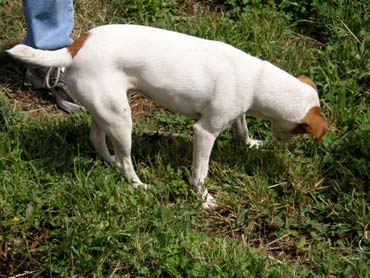 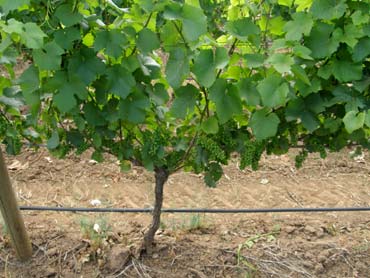 The words Anam Cara are Celtic for “friend of my soul” and symbolize the journey the Nicholas’s have taken to make their wine and the relationship they have with the vineyard. The label depicts the vineyard symbolizing the owners’ relationship with their land, and with each new friend who shares their wine.
 I was impressed by the 2005 lineup of Pinot Noirs (see Volume 6, Issue 36). I briefly tasted the 2006 Anam Cara Cellars Reserve. It is following in the footsteps of the excellent 2005 version with hi-toned black cherry fruit, beautifully spiced and oaked, with a long, sweet finish. Anam Cara wines can be acquired by phone, 503-537-9150, or through the website at www.anamcaracellars.com. Limited Edition Wine Club members receive twice yearly mailings of six bottles of limited production Anam Cara Cellars estate wines including Pinot Noir, Riesling, and Gewürztraminer (a small amount of the latter two white varieties are also grown on the estate vineyard). Anam Cara is open by appointment at the Chehalem Mountain vineyard. Nick and Sheila are always interested in walking their vineyard with guests and opening a bottle or two if supplies permit. They also host a Labor Day Open House in their vineyard. This past year they brought guests into the middle of the vineyard where the four blocks of Pinot Noir converge and encouraged them to sample the grapes from four clones, then shared unblended barrel samples from the same blocks, and finally offered samples of finished wines. The 2006 Estate and Reserve Pinot Noirs will be released on Thanksgiving weekend as well as a limited release of their special bottlings, Heather and Mark, though the Mark is a well-endowed wine that might be held back until next March.
This is a new, small, family owned, boutique producer located in Newberg, Oregon. I have been impressed with the Pinot Noirs and Chardonnay. Well, maybe that is putting it lightly, for the 2006 Rachel Estate and 2006 Jacob Estate are among the best Pinot Noirs I have drank all year and both will be in my All-American list for 2008. I have bought and drank several bottles of the two Pinot Noirs and tested others blindly on the wines to confirm my wild enthusiasm. The wines have consistently shined. Laura makes all the winegrowing decisions herself, performs practically all the physical work in the vineyard, and for the most part, won’t let anyone else touch the vines. In the winery, she is so intense in everything she does, her very tolerant husband (bless him!), chidingly says, “She takes every bottle personally.” She likens her passion and dedication to an author writing a great book who can completely lock into the job at hand. “I have blinders on from April until the end of crush,” she says. Of all the many grape varieties, Pinot Noir is the most temperamental, a fickle prodigy if you will, and the one that can be brought to perform brilliantly only through meticulous parenting in the vineyard and in the winery. This explains why some of the world’s greatest Pinot Noirs come from very small producers who can personally nurse the frivolous grape every step of the way. Laura Volkman personifies this ideal and her wines show the results. The Laura Volkman Vineyard is located about a half mile from August Cellars (a cooperative facility in which several winemakers lease space) in Newberg. Together with her husband, she bought a small farm several years ago, cleared the land and planted vines. Her first releases were from the 2004 vintage. The labels are quite striking and display artwork depicting Laura in her vineyard (by watercolor artist Terry Peasley). I just had to meet Laura and so I did right after IPNC. Her small and charming tasting room is shown below along with her two children Rachel and Jacob, after whom her wines are named. I re-tasted the 2006 Rachel and Jacob Estate Pinot Noirs and they were stellar as were the 2007 versions of the same wines. The wines strike a beautiful balance between flashy flavor and character and elegant pinotosity.
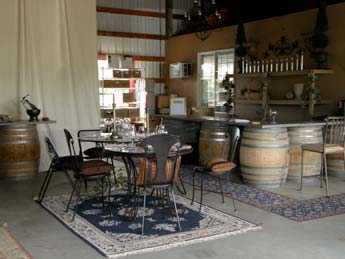 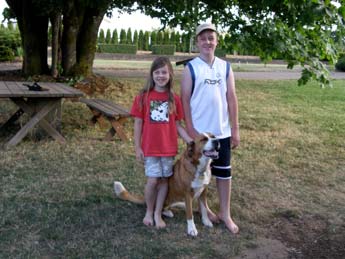
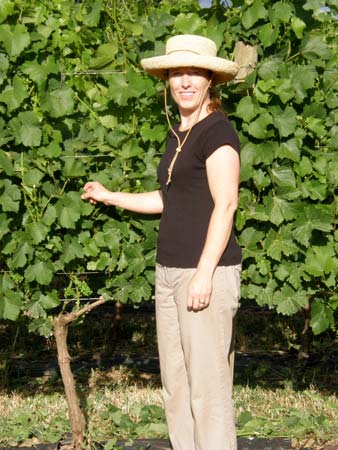 I was curious how she does it, so I asked her to give me her winemaking regimen. No secrets here, just an artisan’s gut feeling at every step along the way. This is what she told me. “I like to dial in the yields in the vineyard in September, based on the amount of heat units we receive during the season - very important for wine quality. For example, I have been dropping more fruit the past 3 weeks (early and mid September) to optimize color and flavor development and frequently tasting berries for maturity. As for winemaking, taste and smell are my primary tools. With Pinot, the de-stemming process is very gentle and mostly whole berry. I cold soak for 5 to 7 days, depending on the levels of ripeness, to extract color and tannins using a gentle punch down process two times a day and tasting my way through the process. I planted five Pinot Noir clones in my vineyard and I ferment each one separately using yeasts to match the clone’s aromas and flavors intrinsic to my soils and site. Yeasts are important in enhancing phenolic compounds and using a variety of yeasts contributes to the complexity of the wines. These yeasts are cool fermenters ranging from 77-85° F. The ferments usually take between 7 and 10 days to go dry. Once complete, I allow the must to soak for another 5 to 7 days, depending on how the wine tastes, before pressing off to barrel. As for pressing, I go directly to barrel on the lees using gentle gravity flow. The free run juice is aged in new French oak barrels and makes up about half of my production. The skins are gently pressed into one and two year-old barrels. I inoculate every barrel with M-L bacteria to kick off secondary fermentation which generally takes 2 to 3 months. After MLF is complete, I keep the barrels topped and the wine rests until it is time to blend and bottle. Blending is part of the “art” of winemaking - a fun but stressful period when everything needs to come together with aroma and flavor! While I am fastidious with juice and wine analyses, you can see my winemaking is as much about smell and taste as it is about science. Ultimately, the vineyard is really the key. Harvest is based more on palate than numbers. The adrenaline rush is overwhelming - the chance to work with a new vintage is like falling in love every year.” Laura Volkman Vineyards winery address is 13000 N.E. Quarry Road, just off Highway 99W in Newberg (August West Cellars). Tasting is by appointment. The wines are sold through a mailing list or by contacting Laura at 503-806-4047. A limited number of specially etched magnums are available each vintage.
Luisa Ponzi met our small group at the construction site of the new “green” Ponzi Winery that sits on a 42-acre parcel between Beaverton and Newberg, perched on Chehalem Mountain. The new winery is aptly named “Collina del Sogno,” which translates from Italian to “Place of Dreams.” The patriarch of Ponzi Vineyards, Dick Ponzi, has been dreaming of this winery for thirty years. The 30,000-square-foot winery is a four-level gravity flow and sustainable facility. Construction is primarily concrete and metal with wood accents. The concrete portion of the building employs fly ash, a waste product from coal-fired power plants. Solar panels provide energy and excess electrical power will be sold or credited back to the electrical company. The building is 80 percent buried in the ground to aid in insulation and with the reflective metal roof, there will be no need for air conditioning. Most of the lighting is provided by strategically placed windows at the top of the building. Rain water will be collected and stored for irrigation and fire suppression. The winery is scheduled for completion in time for the 2008 harvest.
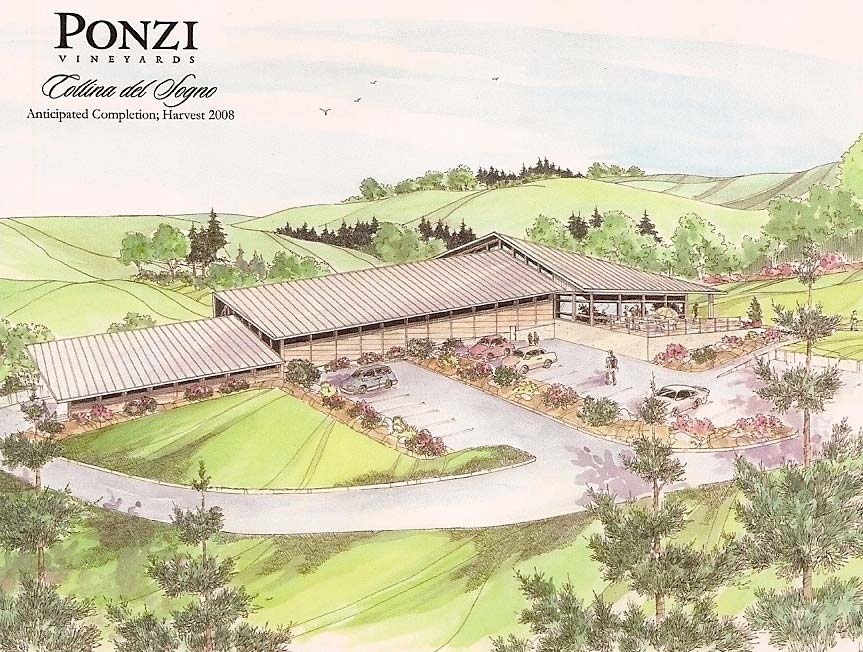 Ponzi Vineyards has been at the vanguard of sustainable viticulture in Oregon, obtaining LIVE certification in 2000 for the existing winery and all the vineyards. Ponzi now farms 120 estate acres in the Chehalem Mountains and along with purchased grapes, produces 50,000 cases of multiple varieties (Pinot Noir, Chardonnay, Pinot Gris, Pinot Blanc, Rosato, Dolcetto, Riesling, Arneis, and a desert wine, Vino Gelato) annually. As we sat outside the old Ponzi Winery and tasting room (which will remain open) under mature shade trees, Luisa Ponzi reminisced about the early days of Ponzi Vineyards. Dick and his wife Nancy were hippies who moved from Los Gatos, California and arrived in Oregon in the 1960s with three kids in tow and a dream of producing world class Pinot Noir. Following trips to Burgundy and an extensive search for a suitable location, they bought a 20-acre farm southwest of Portland in Beaverton, Oregon.
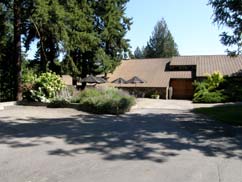 The first 11-acre vineyard was planted in 1970 and a small house and garage was built. The garage became the first winery and was gradually expanded in a somewhat haphazard fashion over the years with the original house becoming a hospitality center (the old winery is pictured right). The first commercial release of Ponzi Pinot Noir was from the 1974 vintage and released to the public in 1976. Producing limited quantities of high-quality, handcrafted wine, Ponzi Vineyards soon established a reputation for world-class excellence. Dick and Nancy Ponzi were instrumental in getting state permission to allow wineries and adjoining tasting rooms to be constructed on agricultural land in Oregon. Together, they helped found the Oregon Winegrowers Association and the Oregon Wine Advisory Board (currently known as the Oregon Wine Board). In 1984 they established Bridgeport Brewing Company, Oregon’s first craft brewery, and in 1998 established a regional wine bar and bistro in downtown Dundee. Nancy Ponzi co-founded the International Pinot Noir Celebration, Oregon Pinot Camp (for retailers), and The Salud Barrel Auction that benefits health care for seasonal workers.
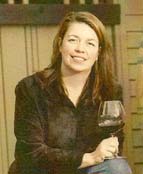 All the children worked in the vineyards growing up as Dick and Nancy Ponzi developed their business. Today the grown children are in charge of the day-to-day management of Ponzi Vineyards. Like her husband, Eric Hamacher, who is a noted winemaker, Luisa had intentions of becoming a doctor and was majoring in biology when she realized medicine was not her calling. She switched to enology, studied in Burgundy, and returned to take over the winemaking reigns from her father in 1993. The same year the other two Ponzi children assumed full-time roles at the winery (Maria Ponzi Fogelstrom as the Sales and Marketing Director and Michel Ponzi as the Operations Manager). As I sat and conversed with Luisa for a couple of hours, interrupted only once by a call about her children (she has four), I was impressed how grounded she was. There wasn’t much winemaking jargon and gibberish or promotion of her wines. It was refreshing to sit and sip, talking and joking about the concerns and life experiences we all have, the kind of conversation that is so conducive to an outdoor setting over a good glass of wine. The wines that were sampled are reviewed below. They are distributed nationally by Wilson Daniels Ltd..
2007 Ponzi Vineyards Willamette Valley Pinot Gris 13.3% alc.,8,200 cases, $17, screw cap. Initial Pinot Gris plantings at Ponzi date to 1978. Fermented in temperature controlled stainless steel tanks. · Crisp white peach aromas and flavors with lively acidity in an Oregonian rather than Alsatian style. Ponzi excels at this variety and I found it perfectly suited to summer dishes.
2007 Ponzi Vineyards Willamette Valley Chardonnay 11.86% alc., 542 cases, $20, screw cap. Stainless steel fermented. Sourced from seven vineyards including Ponzi Estate and Dion Vineyards, both over 30 years old. · Bright and frisky with enjoyable tropical aromas and flavors including banana and pineapple. A good food companion.
2007 Ponzi Vineyards Willamette Valley “Rosato” Rosé of Pinot Noir 12.9% alc., $17, screw cap. 100% Pinot Noir either sourced for Rosato or the result of a saigneé. Grapes come from Ponzi Estate Vineyard and Dion Vineyards. · Appealing salmon color. Pinot Noir in its most pure state, fresh and lively strawberry and red cherry flavors. A good wine for summer BBQ.
2006 Ponzi Vineyards Reserve Willamette Valley Chardonnay 14.2% alc., 416 cases, $30. Barrel fermented, 100% MLF Chardonnay from Dijon clones. 18 months of barrel aging and 6 months of bottle aging. Unfiltered. · Buttery and fruity but retains brisk acidity. Mildly viscous in the mouth with attractive notes of tropical fruits, tart apple and honey and a little spice to boot. Restrained but showy and a winner on all counts.
2006 Ponzi Vineyards Willamette Valley Pinot Noir 13.5% alc., 6,000 cases, $35. Fermented in small lots with five days of cold soak. Manual punchdowns before lightly pressing at dryness. Aged in 30% new French oak for 11 months. Bottled without fining or filtration and aged five months in bottle before release. · A decent Pinot with simple aromas and flavors of cherries, cranberries and strawberries with an oaky component. Slightly velvety in texture with a good acidic charge on the clean finish.
 2006 Ponzi Vineyards Reserve Willamette Valley Pinot Noir 14.3% alc., 700 cases, $60. The flagship Pinot Noir of Ponzi Vineyards and an outstanding wine in each vintage. The blend is selected from older vines of Ponzi’s Madrona, Abetina and Aurora vineyards as well as purchased fruit. Winemaking is similar as for the Willamette Valley blend except a seven day postfermentation maceration is used to increase structure and length. Aged in 50% new French oak barrels for 20 months. Bottled unfined and unfiltered and aged in bottle for five months before release. · A complete wine of great breeding. Lovely aromatics featuring bright cherry and Satsuma plum fruit nicely spiced. Gorgeous stone fruit with subtle earth, oak and tea notes expands in the mouth leaving a lasting and memorable impression. Very harmonious, smooth and stylish. Still tight and will need another year or two to reach a more lofty peak. I have been buying this wine every vintage since 1992.
Ponzi Vineyard wines are available on the website at www.ponziwines.com. Reduced futures prices are offered to those on the mailing list. The Abetina Vineyard Pinot Noir ($100), made in only the finest vintages, is one of Oregon’s greatest wines. The wines are available for sampling at the original winery located at 14665 SW Winery Lane in Beaverton (open daily) and at the Ponzi Wine Bar in Dundee on Highway 99W (also open daily). 503-628-1227.
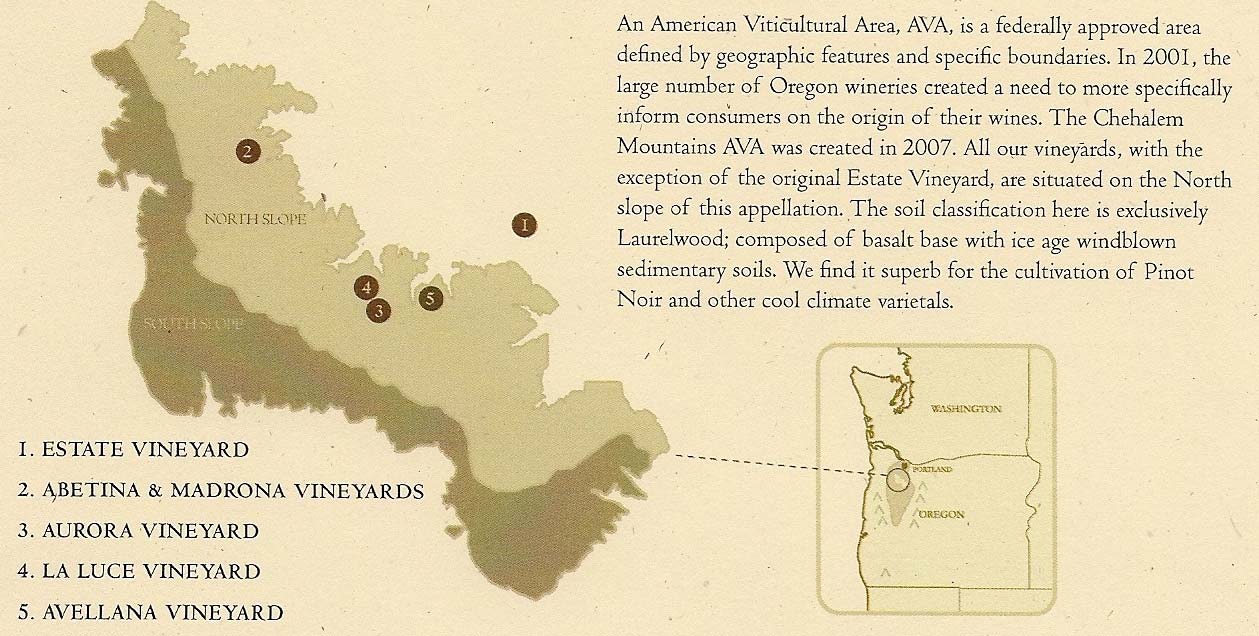
Getting Your Hands on Noiregon JuiceOregon now has an open and non discriminatory direct-shipping law and Pinot Noir can be freely shipped within Oregon and shipped to any state that permits wine shipments (previously Oregon had a reciprocal law permitting shipments to states that only allowed shipments to Oregon). Due to legislation passed in Oregon in 2007 and effective January 1, 2008, any winery or retailer in Oregon can ship up to two cases of wine per month per individual customer. The winery or retailer must obtain a Direct Shipper Permit and pay excise tax. Shipping laws are the bane of wineries and complicated by the variations in restrictions among different states. If you live on the West Coast, you can obtain Oregon Pinot Noir with no difficulty. California, Colorado, Idaho, New Mexico, Oregon, and Washington freely permit intrastate shipping. Pity those who live in states where wine shipments are not only illegal, but also felonies (Florida, Georgia, Indiana, Kentucky, North Carolina and Tennessee). Shipments can be made to the non-allowed states by licensed businesses. (Example: a store in state XX allows you to pay a nominal fee for taxes, etc., and they will receive wine shipments for you. Check with your local liquor or wine store.) Most wineries in Oregon sell their wines directly to consumers through a website and tasting room. Expect to pay full retail unless you are a member of the winery’s futures or wine club program. Dealing directly with wineries has advantages especially when wines are produced in small amounts and allocated. Buying direct and establishing a personal relationship with winery personnel can enhance your wine drinking experience and allow you to gain entrance to special events and the opportunity to buy limited-release bottlings. Retailers can be valuable sources of Pinot Noir. They allow one-stop shopping, offer the experience of having tasted many or all the wines they sell, often provide in-store tastings, and frequently know considerable background information about the wines they offer. I have listed below a number of Oregon retailers from whom I have bought Oregon Pinot Noir. Avalon Wine There have been many offshoots of this business model over the years offering a tasting bar, gourmet foods, and organized wine tastings and classes. Avalon Wine dates back over twenty years and thanks to owner Jean Yates, remains an Oregon original that is THE source for Oregon Pinot Noir. The retail store is located in the 100-year-old Corvallis Arms Hotel in downtown Corvallis. The website is a marvelous source for insight into Oregon wineries and winemakers. The credit goes to Jean who has been connected to the Oregon wine industry since its early beginnings, seems to personally know everyone who makes wine in Oregon, and whose computer background lends educational and visual interest to purchasing wine from her site. The website is www.avalonwine.com and phone is 541-752-7418. The store is located at 201 SW 2nd St. Story Teller Wine Company Michael Alberty is the proprietor of this retail store in Portland and bills himself as the “head storyteller.” Sign up for his email newsletter (www.StorytellerWine.com or 503-206-7029) which is a highly entertaining read featuring extensive personal accounts and humorous anecdotes about wine personalities in Oregon. The retail store is located at 5511-B SW Hood Ave, Portland. I have kept every newsletter and often refer to them for little-known information. Vinopolis Wine Shop This store bills itself as Portland’s largest wine retailer. Wines are often discounted and discounts are offered on purchases of six or twelve bottles. The website is not particularly user-friendly, but offers a decent selection of Oregon Pinot Noirs. Sign up for the frequent email newsletter which simply lists wines and prices. 1025 SW Washington St. 503-223-6002. Website: www.vinopoliswineshop.com. Oregon Wine Merchants This is the online division of Sundance Wine Cellars in Eugene, touted as Oregon’s largest wine retailer and “featuring the largest selection of Oregon Pinot Noirs in the world.” They have plenty of the small production and hard to find Oregon Pinot Noirs with some useful background information offered on the website. 1-800-OR-WINES. The website is user-friendly: www.orwines.com. Oregon Pinot Noir Club An online retailer that sells wine to non-club members and sends monthly shipments of Oregon wines to club members. Nicely presented website which is easily navigable and provides useful information about many of the wines. Good choice of Oregon Pinots. Website: www.oregonpinotnoir.com. Wine-searcher has a list of Oregon wine retailers (www.wine-searcher.com). Free online searches for Oregon Pinot Noir: www.wine-searcher.com, www.vinquire.com, www.winezap.com, and www.wineaccess.com.
Noiregon Pinot BriefsWine Country Thanskgiving This three-day weekend features tastings at more than 120 Willamette Valley wineries with artisan foods, live music, and local artists. The 26th annual Wine Country Thanksgiving runs from November 28-30, 2008, from 11:00 AM to 5:00 PM each day. This annual event is traditionally held the weekend after Thanksgiving. Many small, family owned wineries are only open to the public Thanksgiving and Memorial Day weekends allowing for opportunities to meet the winemakers and sample the newest releases. Visit www.willamettewines.com or call 503-646-2985 to request a touring map and guide or obtain your free copy throughout Oregon at visitor associations, hotels, wine stores and travel centers. A similar open house weekend is held in the spring, Memorial Weekend in Wine Country, May 23-25, 2009. Salud! Oregon’s Pinot Noir Auction Now in its 17th year, Oregon’s Pinot Noir Auction has raised over six million dollars for the Tuality Healthcare Foundation to support efforts to bring healthcare to seasonal vineyard workers and their families. This year’s event will be on November 7 & 8, 2008. At the Big Board Case Auction, guests can bid on Oregon Pinot Noirs created especially for Salud!. The black-tie Dinner and Auction includes a live and silent auction of rare wines, special dinners with winemakers, and unique wine trips. For information and to join the mailing list, visit www.saludauction.org. McMinnville Wineries For a relatively small town of 30,000 people, McMinnville has an inordinate number of wineries - 19 at last count. They include Anthony Dell Cellars, Black Cap Wines of Oregon, Coeur de Terre Vineyard, Coleman Vineyard, Evergreen Vineyards, the Eyrie Vineyards, La Bête Wines, Maysara Winery, NW Wine Co., at NW wine Bar (over 20 custom crush labels including Soléna Cellars, ArborBrook Vineyards, Folin Cellars and Piluso Vineyard & Winery), Panther Creek Cellars, R. Stuart & Co., Ransom Wine Co., Sol et Soleil Cellars, Stevenson-BArrie, Stone Wolf Vineyards, Westrey Wine Co., WineWorks Oregon (custom crush labels including Bernard-Machado, Carlton Hill Wine Co., Robinson Reserve, Walnut City Wineworks, and Z’IVO Wines), Yamhill Valley Vineyards, and Youngberg Hill Vineyard & Inn. McMinnville was first established in 1843 when William T. Newby arrived in Oregon by wagon train from McMinnville, Tennessee.
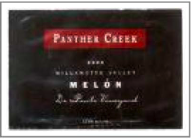 Melon Makes a Tiny Foothold in Oregon Melon de Bourgogne, labeled Muscadet in Europe, is an offspring of Pinot Noir, a result of the cross between Pinot Blanc (with which it is often confused) and Gouias Blanc. Most of France’s Muscadet comes from the area around the city of Nantes on the Loire River in proximity to the Atlantic Ocean. Muscadet is a classic match for shellfish and is known for its bright lemon crispness. Several Oregon producers are playing with the varietal including Biggio Hamina Cellars, DePonte Cellars, Chateau Lorane, Elemental Cellars, and Panther Creek Cellars.
 Domaine Serene’s Monogram Most Expensive Pinot Noir Monogram is a special limited bottling of Pinot Noir from Domaine Serene’s cellars that represents a few special barrels from select vintages that have the character, concentration and age ability to stand out. The 2005 Monogram has just been released with a winery price of $225 per bottle, the highest release price for a domestic Pinot Noir that I can recall. The 2003 vintage (there was no 2004 vintage) sold out in just over a week. Only 200 six-bottle cases are produced. Members of the mailing list were offered the wine initially and the wine may be sold out as I write this. The wine even has its own website at www.monogramwine.com. Contact Amber Sagnotti at 866-864-6555. Oregon Wine Press This monthly newspaper will keep you informed on the happenings in Oregon’s wine regions. Features include profiles of new and established wineries and winemakers, general wine news, foods and restaurants of Oregon with recipes, and an extensive calender of wine related events throughout Oregon. A yearly subscription is $20, postage included. Mail your order to Oregon Wine Press at PO Box 727, McMinnville, OR 97128.
More Reading On Noiregon
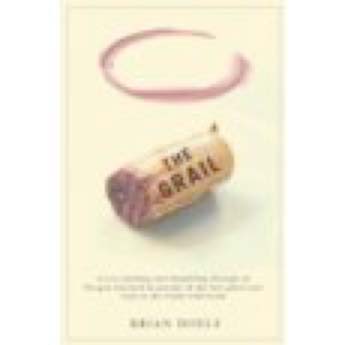 The Grail. A year ambling & shambling through an Oregon vineyard in pursuit of the best pinot in the whole wild world. Brian Doyle, Oregon State University Press, Corvallis, 2006, 208 pp, paperback, $18.95. I read this book on a recent flight to Australia and it kept me entertained the entire trip. The diary chronicles the author’s experiences intermittently hanging out at Lange Winery in Dundee, Oregon, following a vintage with winemaker Don Lange and other members of the winery crew. Doyle asks plenty of questions and gets a plethora of practical answers about winegrowing and winemaking. He sprinkles the story with interesting historical facts on Pinot Noir as well. An author of six books and editor of Portland Magazine at the University of Portland, Doyle is a talented and humorous writer who had me laughing out loud at several points in the story. Examples of some of his pithy quotes: I don’t know if you could possibly stumble into two careers that entail less profit for more labor than making music and making wine.” “Making wine is not an art, but it most certainly is a craft, and some people are masters at it.” One factoid I learned can be used to stump your wine geek friends. What is the name of the tool for punching down the must in the fermenter? Answer: The tool has no name. Zing! Vineyard Memoirs or “So this is what it’s like to plant a vineyard?” Kerry McDaniel Boenisch, Sheridan Books, Ann Arbor, Michigan, 2004, 112 pp, paperback, $19.95 ( available from Vineyard Memoirs, PO Box 512, Dundee, Oregon 97115, enclose $3.00 for S&H or phone BooksAmerica at 1-800-929-7889). Kerry McDaniel Boenisch writes about her recollections of living, grape-growing and winemaking in the 1970s when the modern Oregon wine industry was born. McDaniel is a resident of Dundee and dedicated her book to Loie Maresh who encouraged McDaniel to write this memoir. McDaniel’s parents, Jim and Donna Jean McDaniel, purchased three separate acreages in the Red Hills above Dundee in 1973 and the family planted vineyards on all three. Today, the original house and vineyard is Torii Mor Winery (for the fifteen years the McDaniels lived and worked there it was known as McDaniel Vineyards). McDaniel shares much personal information about people and families that were early winegrowing pioneers in the Red Hills including Arthur and Vivian Weber, Jim and Loie Maresh, Martha Maresh, Susan Sokol-Blosser and Bill Blosser, Bill and Bessie Archibald, Dick and Kina Erath, Charles and Shirley Coury and several others. A casual and informative read for lovers of the history of the early days of Oregon Pinot Noir.
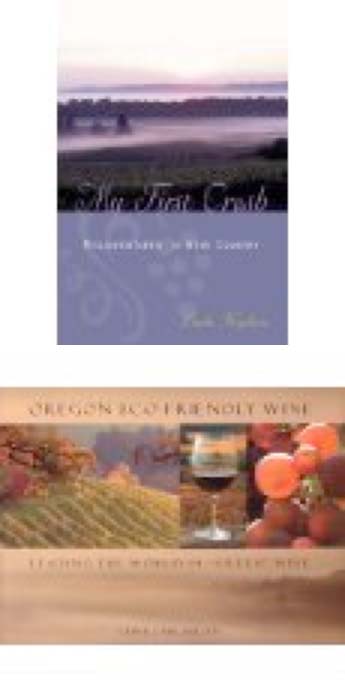 My First Crush. Misadventures in Wine Country Linda Kaplan, The Lyons Press, Connecticut, 2005, 214 pp, hardcover, $22.95. Linda Kaplan’s spouse left his law practice in Iowa after buying Panther Creek Winery and the two came to McMinnville, Oregon with no formal training in winemaking. This memoir details the challenges of the uninitiated making a premium Pinot Noir in Oregon while adapting to a completely different lifestyle. Numerous tips are included about enjoying wine and food. The preface includes a cheeky one-page recipe for producing 36,000 bottles of Pinot Noir. If you have ever even had the slightest inkling that you wanted to drop everything and move to wine country and make wine, read this book first. Oregon Eco-Friendly Wine: Leading the World in “Green” Wine Clive S. Michelsen, Wine Appreciation Guild, 2007, 264 pp, hardcover, $39.95. The methods used by well-known Oregon wineries to produce “green” wine are detailed. The author’s favorite wines are highlighted and there is a complete winery directory with tasting room hours and contact information. The included summary of Oregon’s AVAs is a helpful reference. The Two-Lane Gourmet: Fine Wine Trails, Superb Inns, and Exceptional Dining Through California, Oregon, and Washington Tom Snyder, St. Martin’s Griffin, 2007, 272 pp, paperback, $16.95. A comprehensive guide to wineries, B&Bs and fine eateries along the wine road in three states. There is also quite a bit of general wine information for beginners such as how to taste wine and a glossary of wine terms. Note: These books are heavily discounted at www.amazon.com.
The Map Store
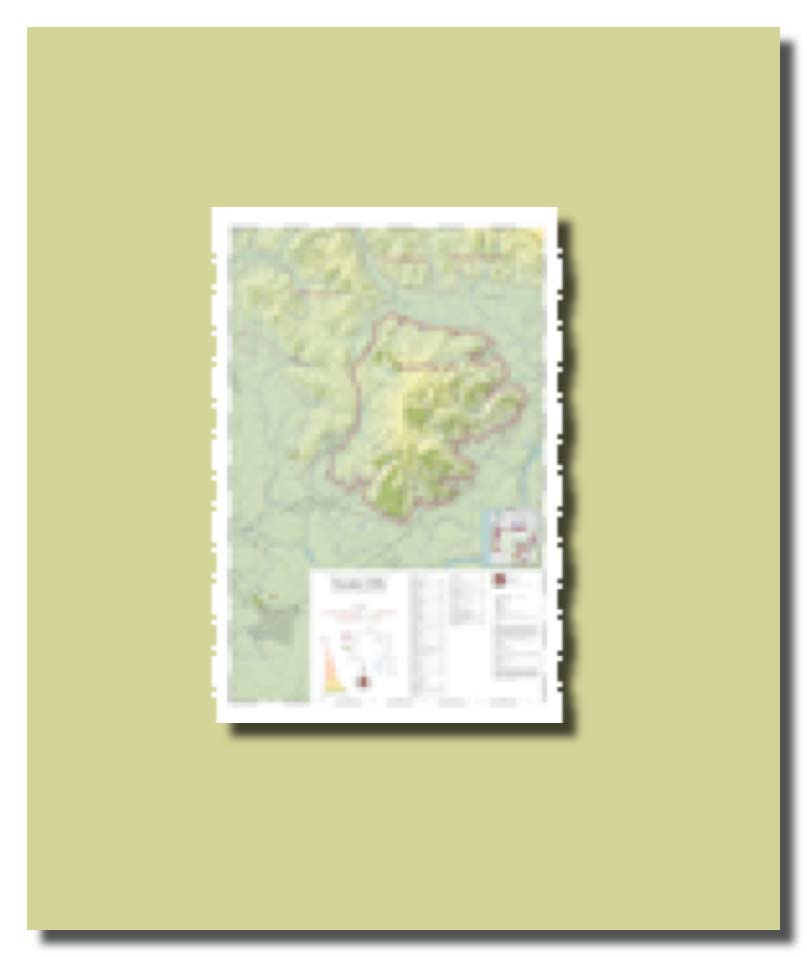 The Map Store in Windsor, California is the leading producer of high-quality quality printed maps of Sonoma and Oregon wine regions. The Oregon Wine Board has commissioned a series of viticultural maps of Oregon including separate maps of all the major AVAs and sub- AVAs of the Willamette Valley. The Dundee Hills map is depicted to the right. These maps show details of Oregon vineyards as well as winery and tasting room locations. Wineries and growers who wish to participate can log in to the website to submit winery and vineyard information. The maps are sold for $34.95 on the store's website, www.themapstore.com. The online version of the Oregon maps is not yet available but wine information can be viewed on Google Earth on the website. The Map Store is located at 9091 Windsor Road in Windsor, CA. The phone is 707-838-4290. I have several of the paper maps at home and refer to them almost daily. They also add a decorative touch to any office when laminated and hung on the wall.
Join the Crew
Please note: The PrinceOfPinot.com is now a free website. This is an old article.
You may obtain an annual subscription to the PinotFile anytime after September 5, 2008, using a secure credit card transaction through PayPal or sending a check (follow instructions on the website). Use the “Join the Crew” button on the website. The Prince of Pinot home website at www.princeofpinot.com will be completely accessible to everyone until October 5, 2008. After October 5, only subscribers will have full access using an i.d. and password. The biweekly newsletter will no longer be e-mailed to subscribers. Rather, subscribers will receive notification by e-mail (from princpinot@gmail.com beginning with PinotFile.....), when a new issue is on the site. You can then read, download, and print a copy of the PinotFile. Past issues will always be available for reference and reading. You may also sign up for a RSS feed to be notified immediately when a new issue or other information is posted on the site. An annual subscription consists of 26 issues: over 500 pages of pinotspeak and unlimited access to bonus online content. An automated notice will be sent by e-mail to you at the time of expiration of your subscription alerting you of renewal. You are free to cancel at any time. When you subscribe, you will receive an e-mail confirmation from PayPal and your subscription will be immediately made active. If you have any problems with obtaining your subscription or navigating the website, please contact Peter Rowell at support@princeofpinot.com.
|

